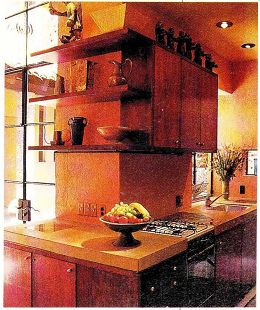
------- A stretch of open shelving in this kitchen provides display and storage while balancing long expanses of closed cabinetry.
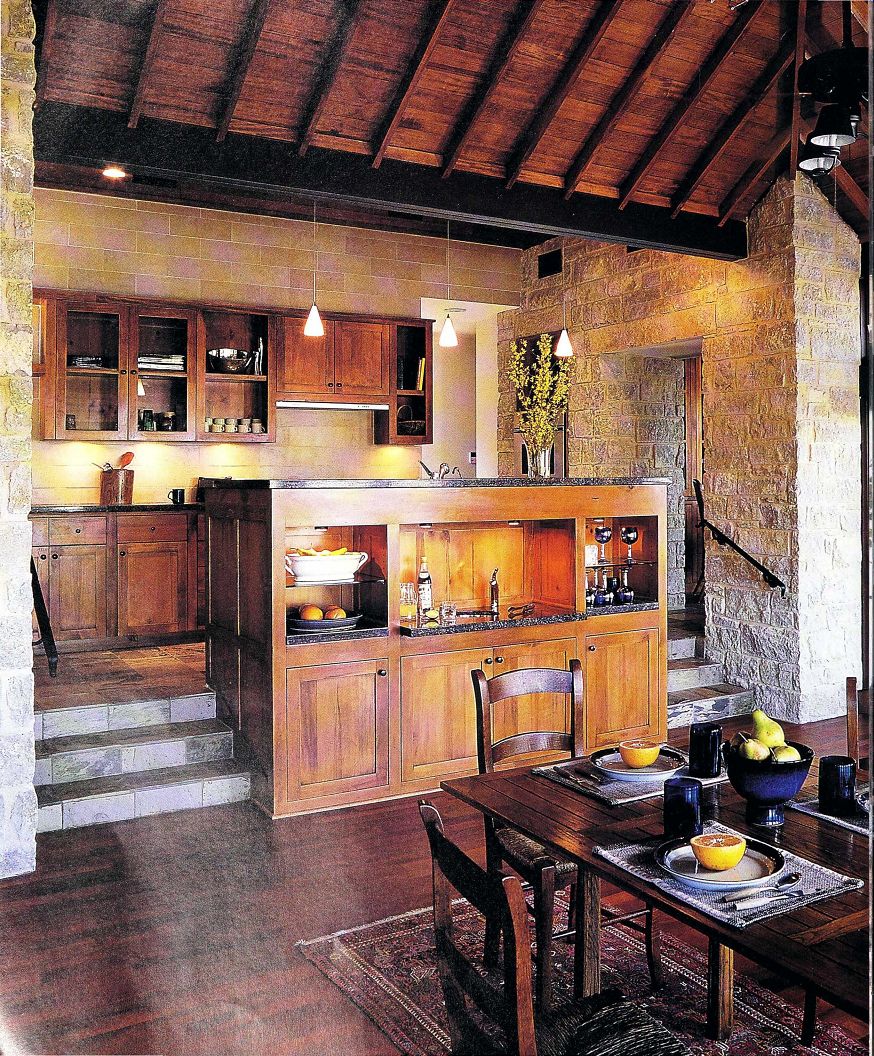
-------------- This architectural gem, hewn from wood and stone, incorporates
a wide range of storage possibilities that complement one another in both practical
and aesthetic terms. The built- in piece in the middle of the room acts as
a kitchen island on one side and a wet bar on the other. A combination of closed
and open cabinetry creates visual interest, as well as storage space that's
conducive to all manner of kitchen gear.
A kitchen is prime real estate. It has the most expensive square footage of any room in the house, and it's the place everyone wants to be. A kitchen is also the repository for the widest variety of items in the house, making it a likely source of chaos unless its storage space is well thought out. Cookie-cutter cabinetry-wall cabinet over base cabinet, drawer over door--is all too often the only space allocated for storage, and it never seems to provide enough room for everything. Pots and pans end up in a jumbled heap, while fine china and everyday dishes make dangerous bedfellows in overcrowded cabinets. Utensils tangle and jam shallow drawers, and there's no room to prepare dinner because the counters are strewn with clutter that doesn't have a permanent home. But kitchen storage doesn't have to be an accident wailing to happen.
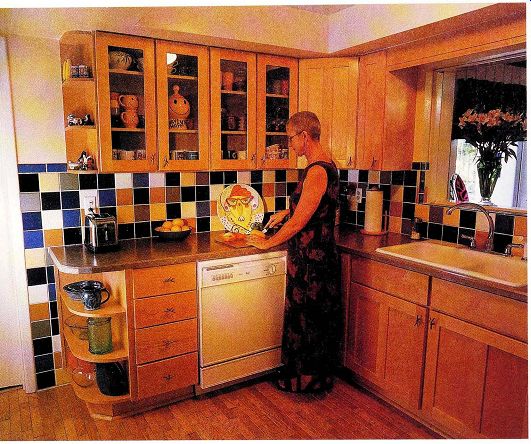
-------- Thanks to a smart remodel, this tiny kitchen--100 sq. ft.-has
become fully functional.
A range used to be where the dishwasher now is; moving it to a bare wall al lowed for an additional 2 ft. of counter space and lots of extra storage above. Drawers contain small tools and supplies, a lazy Susan stores pots and pans, and pullouts under the sink hold garbage and recycling.
For one thing, cabinetry can be built to handle specific needs. Base cabinets can be outfitted with drawers instead of doors if it better suits your needs, and wall cabinets can be designed with open shelves. Or forgo a few cabinets and attach shelves directly to the wall for extra-easy access.
Dishes, particularly the formal variety, may be better off in freestanding furniture, such as an armoire or hutch. And pantries are reemerging as a modern necessity as more households buy in bulk. You'll find all these storage options in this section, as well as suggestions for storing specific items--the equipment and tools you need for cooking, cold foods and dry goods, spices, wine, cookbooks, and more prosaic items, including garbage and cleaning supplies. And since the kitchen has become more than just a place to prepare meals, you'll find ways to make space for a desk and its accessories, for children to work and play, and for the display of more artful items.
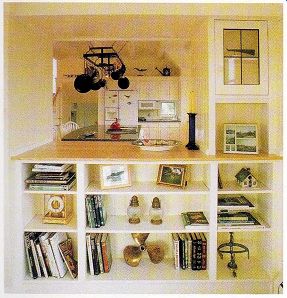
----- There's plenty of room for storage in this Martha's Vineyard kitchen
without resorting to wall cabinets, which would block the captivating views.
Tall base cabinets with a drawer over each, corner storage shelves, and a pot
rack all meet specific storage needs. The arrangement allows for a pass-through
to the dining/living space, which supplies additional work and storage space.
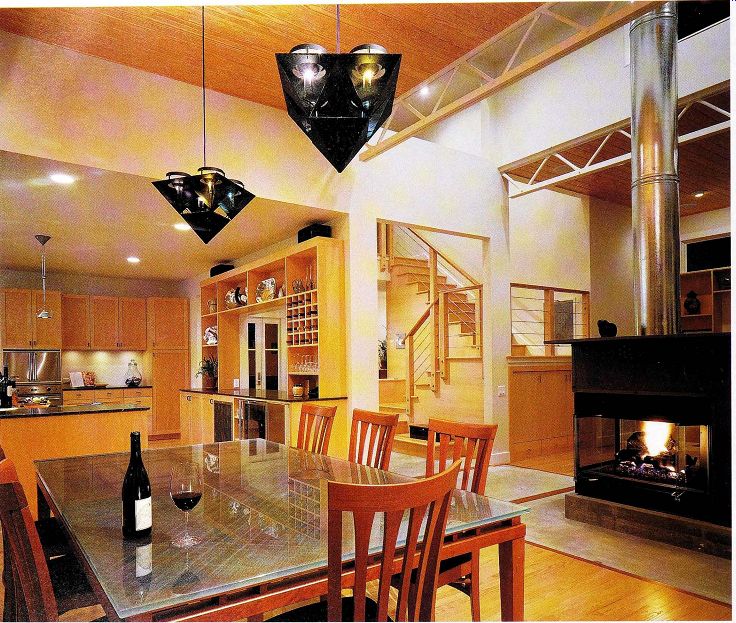
-------- A wall of frameless maple cabinets with flush overlay flat-panel
doors and drawers is a striking feature in this contemporary house. The tall
cabinet in the corner of the kitchen is a pantry. To keep up with an active
entertaining schedule, the homeowners installed an under-counter refrigerator
for beverages and cocktail fixings.
Storage Options
Your personal style will dictate how you designate storage space in the kitchen. If you lean toward modern design, select sleek cabinets, streamlined shelves, and unfussy hardware. If you prefer more traditional elements, you might choose a Craftsman-style kitchen that features wooden cabinets in concert with built-in benches and shelves. Aficionados of restaurant-style kitchens might store much of their kitchen gear and nonperishable food out in the open on stainless-steel wire racks and open shelving.
The way you use your kitchen will also influence how you create storage. Do you prefer a compact space for cooking with an adjacent (but out-of-the-way) spot for kids doing homework or guests keeping the cook company? Or is the kitchen a large, common room designed to accommodate multiple, simultaneous activities. The storage needs of these kitchens will be different, but regardless of personal style and kitchen habits, you'll benefit from creating a range of storage options. A selection of cabinetry, open shelving, and pantry storage ensures not only a handsome kitchen, but also one that operates smoothly. If you balance three walls of cabinets with a generous opening into a family room, or contrast closed cabinets with open storage, your kitchen will feel more open and more serene.
Functionality can (and should) coexist with aesthetics, which will make time spent in the kitchen more productive and more pleasurable.
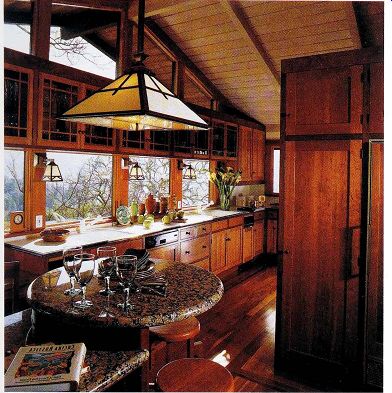
-------- A kitchen with a high, gabled ceiling makes it possible to enjoy
the view yet still have room for wall cabinets. Glass backs to the cabinets
would have brightened the kitchen even more but also would have required more
frequent and fastidious cleaning .
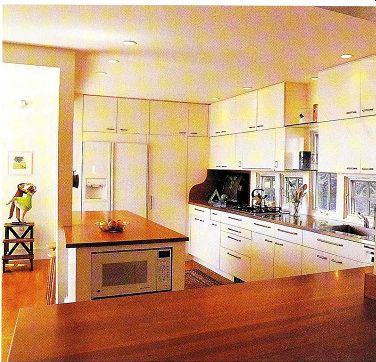
-------- Two walls of crisp, white, painted cabinets with flush overlay
doors and drawers are punctuated by a collection of fixed and operable windows,
as well as glass display shelves (shelves are lit by halogens at night) . The
upper row of wall cabinets overhangs the lower wall cabinets by % in.
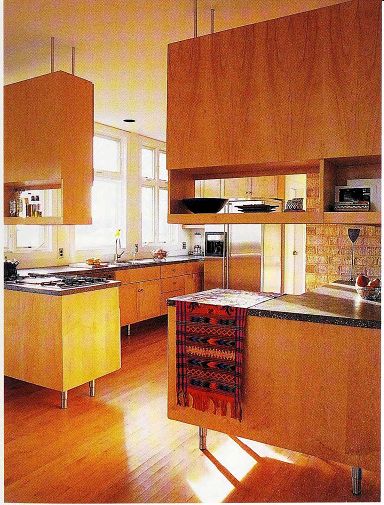
---------- No wall cabinets here: These are hung from the ceiling, allowing
light from the huge kitchen windows to bounce into the breakfast nook.
Frameless base cabinets are supported on stainless-steel legs rather than being anchored to the floor-a purposefully light and modern detail.
A Harmonious Mix of Texture, Color, and Shape
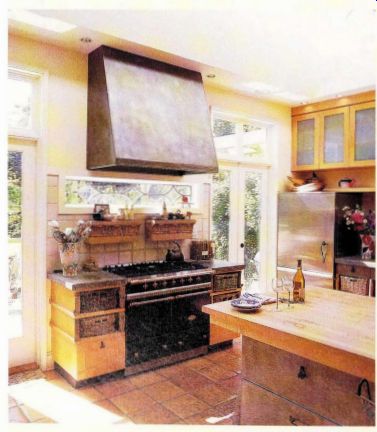
-------------- Thanks to a breathtaking variety of materials and types
of storage in this kitchen, there is no sign of clutter, as much of the storage
is hidden in drawers and behind frosted glass doors. The few open shelves on
this side of the kitchen display objects both pleasing and useful.
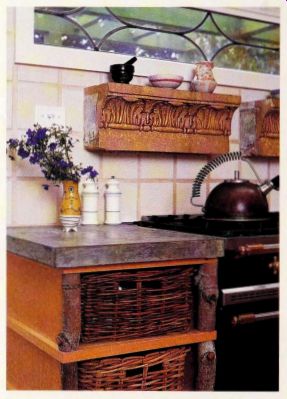
------------ Reclaimed terra-cotta coping pieces create appropriate shelves
for a few traditional kitchen tools, such as a mortar and pestle and an Italian
oil cruet.
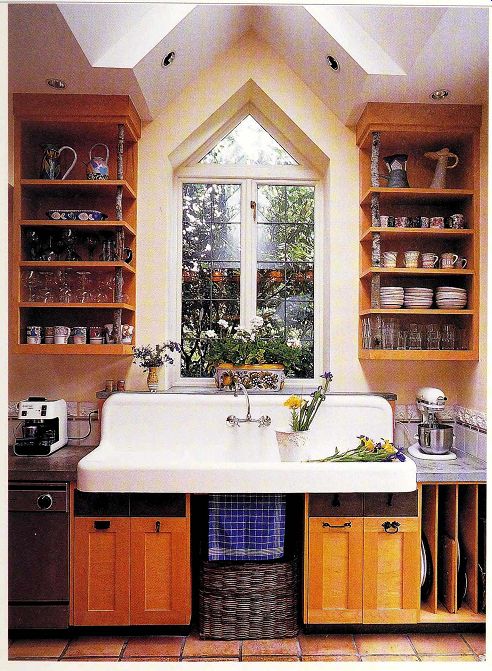
-------------- The aspen branches that appear to hold up shelves, countertops,
and even the island cabinets actually have their cores drilled out and are
slid over supporting cables or rods .
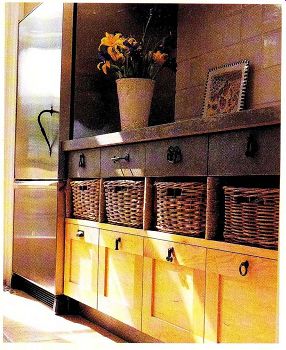
-------------- Although each of these drawer pulls is different, all are
wrought iron and of similar heft. Even the refrigerator door has been fitted
with a custom wrought-iron handle (the freezer drawer opens by a built-in,
full-width pull).
It's hard to imagine that this bright, beautiful, family kitchen was once dark and cramped . Seattle architect Geoff Prentiss took on the task of evoking a Tuscan farmhouse, creating a kitchen that is both eclectic and unified. The storage changes from floor to ceiling, with each horizontal layer creating a different level of openness; from closed cabinets and open shelves to semitransparent storage in the form of baskets and frosted-glass doors, this kitchen has a little bit of everything.
Prentiss made the kitchen rich in history and variety by using a restored cast- iron sink and terra-cotta coping pieces (rescued from a demolished Seattle building) which make hefty, stylish shelves over the massive French range. Despite the mix of color, texture, and shape, the kitchen feels placid, thanks to a deliberate use of symmetry and repetition, and a mellow palette of colors that are earthy and warm. Each wall contains symmetry of some kind-shelves and cabinets flank the sink and range, and drawers are aligned with like materials in rows. Around the perimeter, maple, flat-panel drawers anchor the base cabinets, while the upper portion is left open and filled with baskets. Other materials are repeated throughout the kitchen, such as the toe-kicks, drawer fronts, and range hood, all of which are pre-rusted and then sealed steel. Almost all of the base cabinet storage is provided by drawers of varying sizes crafted in a variety of materials, providing versatile storage for a range of items, from pots and pans to dish towels.
Eclectic Storage in a Cozy Kitchen
When the owner of this kitchen asked architect Tom Vermeland for a "simple house that doesn't look designed," he complied by creating the essence of an old English cottage, mixing built-ins and free-standing furniture, and using a variety of colors and textures. There are no standard wall cabinets in this kitchen; instead, storage is handled with more old-fashioned solutions like open, fixed shelves, an armoire for dishes, and a built-in cabinet that extends all the way to the countertop as if it were a hutch . A walk-in pantry, an invaluable detail in many old houses, also helps make up for lost cabinet space. The arched niche (complete with ventilation), where a restored 1930s range holds court, also gives the sense of a kitchen from a different time. The overall effect is one of charm, comfort, serenity, and-as the client wished-a sense of design with a small "d."
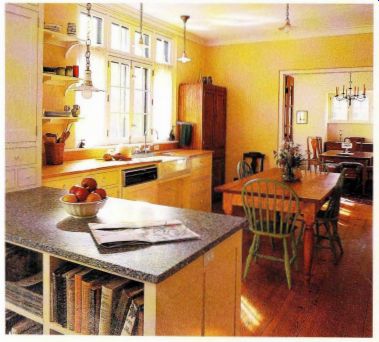
------- Storage comes from many sources in this comfortable kitchen. An armoire
conveniently houses fine china near the dining table, and base cabinets with
drawers handle pots, pans, and small tools. A floor-to-countertop cabinet has
additional storage, while everyday dishes are displayed on open, fixed shelves
near the dishwasher. Open shelves for cookbooks face a sitting area.
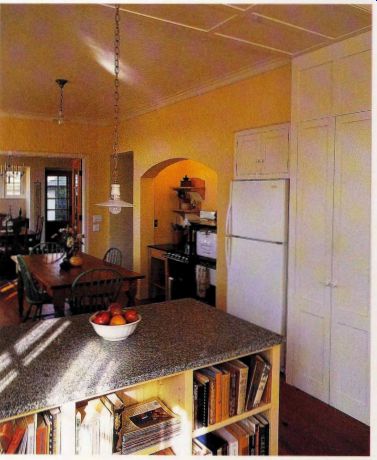
-------- The 1930s range was salvaged from a relative's basement, restored,
and installed in a ventilated cooking niche. Storage for a few pans and small
cooking tools is supplied by a small table and two fixed shelves.

--------- Basic Cabinet Types: Adjustable legs simplify installation but
need finish trim.
Inside of cabinet is completely accessible when door is open. FRAMELESS CABINET FACE-FRAME CABINET -- Exposed hinges are not adjustable and are visible when door is closed. Concealed, adjustable hinges are available, too.
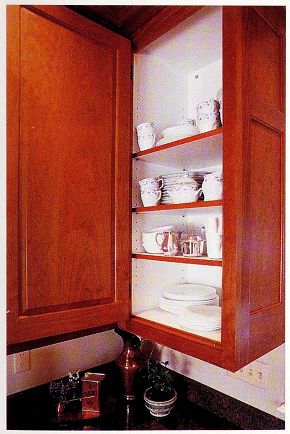
------------ Traditional frame-and-panel, solid cherry doors open to a
plastic- laminate interior that's bright and easy to clean. Edges are banded
with cherry to match the doors.
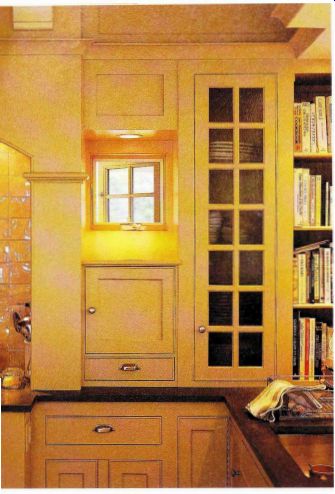
----------- This kitchen features a clever and diverse use of space, with
an assortment of closed cabinets, small drawers for tools, a cupboard for small
appliances, a glazed cabinet for dishes, and open shelves for books.
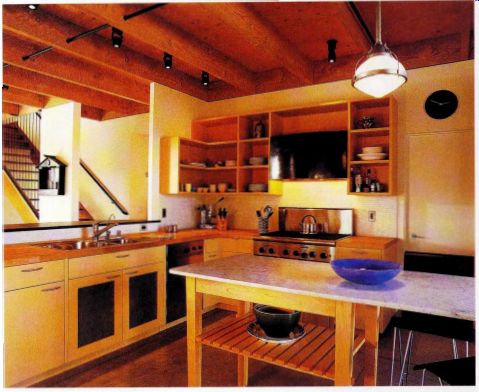
------------- A This kitchen has an agreeable balance of open shelving and
closed cabinets, and there's even a middle ground with screened panels on base
cabinet doors. Rather than fill the wall over the sink with cabinets, it is
opened to create a connection with the family room.
Cabinet Basics
By far, cabinetry is still the most common and versatile type of kitchen storage, and it's also the most expensive.
Whether you're remodeling or starting from scratch, there are seemingly endless cabinetry options, which can be overwhelming. Start by following your first impressions. Even if you don't know the terminology, you probably already have a preference for face-frame rather than frameless cabinets and inset doors rather than overlay doors, or vice versa. But knowing how to ask for what you want will ensure that you get it.
Face-frame cabinets are traditionally American and are still the most popular cabinet style manufactured. A solid-wood frame is attached to the case, and doors either overlay the frame or are inset flush with the frame (more expensive because it's more precise). The European-born frameless cabinet gets its strength from a thicker case and requires no stiffening face frame. Because the case itself has thin edges, doors and drawers overlap so that they almost touch. Frameless cabinets have long been associated with sleek modern styles, but today's frameless cabinets can look completely traditional with panels and molding. Both cabinet types can be fitted with adjustable concealed hinges, but for true period-style cabinets, a face-frame cabinet with inset doors and butt hinges should be selected. What's the difference as far as storage goes? For the same-size box, face-frame cabinets have a little less room because the projecting frame makes it more difficult to fit items snugly in a cabinet, and the drawers must be somewhat smaller to fit within the face frame. Otherwise, the differences are largely stylistic.
Cabinet style affects drawer storage, too. Traditional drawers open by gliding on wooden slides, and a few cabinet-makers still make them that way, but the majority of drawers are fitted with steel slides and nylon rollers or ball bearings, which are more durable and stable. If you're purchasing high-end drawers with elegant details, such as dovetails, you might not appreciate side-mounted drawer slides detracting from the aesthetics when the drawer is open. Under-mounted drawer slides are another option. They're more expensive than side-mounted slides, and they reduce the depth of available drawer space, but they allow for more width because the slides don't eat up space on the drawer sides. Under-mount slides can handle a lot of weight but expect to pay more than for side mounts with the same capacity-and check manufacturer specifications before planning to use under-mount slides on a large pot drawer.
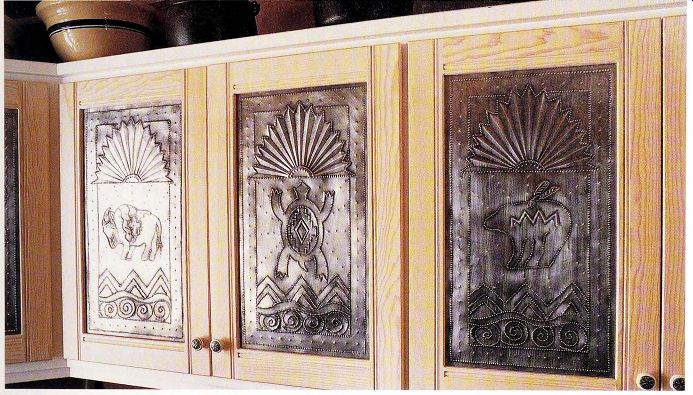
------------ These custom cabinets feature tin renderings that create a
front panel for the cabinet doors, proving that the sky's the limit when it
comes to custom design. The cabinets stop just shy of the bead-board ceiling
to make room for a di splay of cast-iron pots and ceramic bowls.
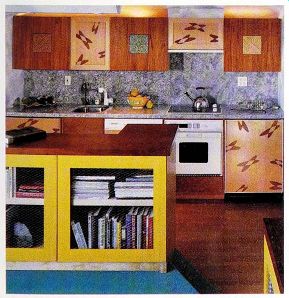
------- Adjacent cabinets definitely don't need to match, and these custom
cabinets were created to complement each other's patterns, colors, and styles.
Because they were made to order according to the homeowner's whimsical vision,
they are one-of-a-kind and perfectly suited to this kitchen's specific storage
needs.
Cabinet sources
Deciding where to buy your cabinets can be just as daunting as choosing a style. These days, there's a huge range of products, from do-it-yourself to custom-made, and everything in between, with an equally vast range of prices. Skilled homeowners may enjoy the challenge and cost savings of knocked-down (KD) or ready-to-assemble (RTA) cabinets. Look for KD cabinets at retailers like Ikea; RTA components are often sold exclusively to contractors or cabinetmakers, but it's worth investigating.
------------------------
Island Storage
The kitchen island has been around for centuries, but in most cases, solely as a work space. Today's smarter islands harbor a wealth of storage whether in cabinets, shelves, or on hooks and bars. Even if people will be sitting at the island, it ca n still accommodate storage; cabinets or shelf units can be installed on opposite ends with open space in the middle. If storage takes priority, the entire island can be filled with cabinetry.
An island countertop provides its own wealth of storage space, but it can easily become cluttered and useless for food preparation if it turns into a dumping ground for mail, cookbooks, and other shelf litter-make sure that kind of storage has a designated spot elsewhere.
When selecting an island, keep in mind that freestanding islands are more flexible, but you'll need a built-in if you want to incorporate electrical outlets. An island with wheels is a good choice for kitchens with multiple cooks.
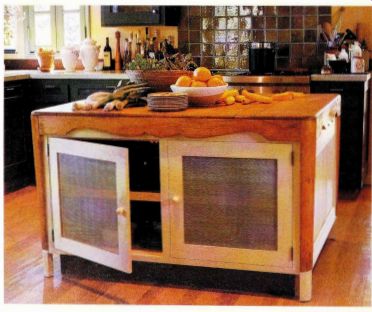
------- An old chest is given new life as a kitchen island. The unit provides
pot and pan storage that's partially obscured by screened panels.
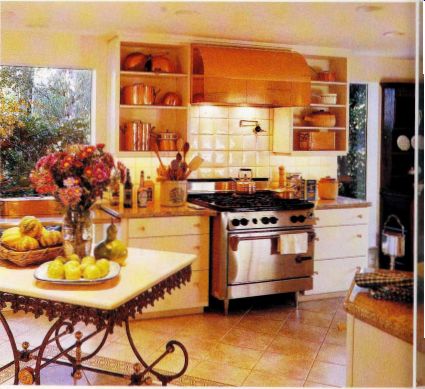
--------- Cooking in this kitchen is made easy by ample storage in open
shelves and wide, deep drawers. The filigreed island has multiple functions,
providing a work space, storage space, and a serving counter.
-------------
-----------
The Inside Scoop on Wood Cabinetry
We say we have wood cabinets, and we' re right in a way, but cabinets are rarely made from solid wood, except for the frames and doors of custom face-frame cabinetry. Most components are actually made from panels, also called sheet goods or engineered wood, either of which may receive a veneer of wood.
Sheet goods are manufactured from wood, wood by-products, and even non-wood sources. The most common are plywood, medium-density fiberboard (MDF), and particleboard. Plywood is stronger and lighter than MDF and particleboard, it's easier to curve, and it holds screws better. But it's also more expensive and not as smooth , making the veneer application more difficult.
A recent development, combined-core plywood, utilizes the best qualities of sheet goods by sandwiching plywood between layers of MDF or particleboard. The result is a smoother, lighter panel that holds screws well. Don't think of engineered wood as a lesser cousin of wood, however , because overall, it's actually more dimensionally stable than solid wood.
--------------------
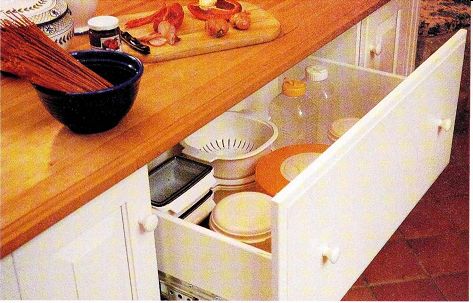
---- A wide, deep drawer next to a butcher-block work space provides
ample room for a salad spinner, storage containers, and work bowls.
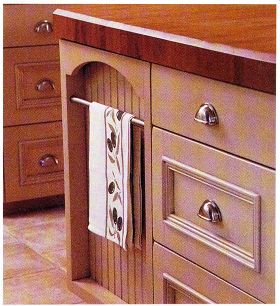
---------- Drawer details differ according to the size of the drawer. Shallow
drawers have flush flat panels while deeper drawers can handle a panel with
molding. One recessed panel keeps dish towels out of the way but within reach
of the cook.
------------
These cabinets allow you to mix and match hardware, styles, and colors, but they also require patience, precision , and a willingness to be responsible for installation.
Stock cabinets come in standard sizes and finishes; they're generally the most affordable option (if you're not doing it yourself and are available off the shelf or within a few weeks. Semi custom and custom cabinets after a much more extensive selection of styles, finishes, and sizes than stock cabinets, and, not surprisingly, they also cost quite a bit more. But if you have very specific ideas about what you want or if you have an unusually configured kitchen, custom cabinets can be designed to your exact specifications.
Depending on how customized your cabinets are, it can take 6 to 20 weeks for delivery.
Drawers vs Doors. In the 1950s, Cornell University conducted a landmark kitchen study, but it took half a century for consumers to embrace one of its primary findings--that the more drawers the merrier in the kitchen.
For years, the cabinetry standard was one medium-sized drawer over a base cabinet with fixed shelves and one or two doors. This design still works for some people, but many of today's kitchens are justifiably drawer happy.
Increasingly, drawers are replacing shelving in base cabinets, which makes great design sense in many cases; instead of rummaging through a dark cabinet on your hands and knees for the pasta boiler, you can simply pull open the pot and pan drawer. Drawers closest to the countertop are often the most shallow, while subsequent drawers are deeper, but that isn't a hard-and-fast rule. They can be designed in any dimensions that suit your needs. A deeper top drawer is perfect for boxes of wrap and foil, smaller tools, or that "useful" stuff everyone seems to collect. Super-deep drawers should be reserved for the big stuff, such as pots and pans; a 10-in.-deep drawer packed to the brim with utensils will prove futile--if not downright maddening.
Corner cabinet. Corner cabinets can be a curse or a blessing. They offer a respectable amount of extra storage space, but if they're not set up with care, they're rendered useless, not to mention annoying. Cabinet manufacturers offer a number of accessories to help consumers better utilize this space , including lazy Susans and pullout racks of varying complexity. Lazy Susans can be the perfect solution, but not if items come flying off every time the unit is spun around; some have a high rim, or, even better, a curved backing, both of which will help keep items in place. If you don't need the extra cabinet storage, forgo corner base cupboards al together and make the space an open garage for a rolling garbage pail or a step-ladder. For corner wall storage , open shelving is a great alternative to closed cabinetry; in addition to offering easier access, the shelves will open up the kitchen and provide an eye-pleasing counterpoint to closed cabinetry.
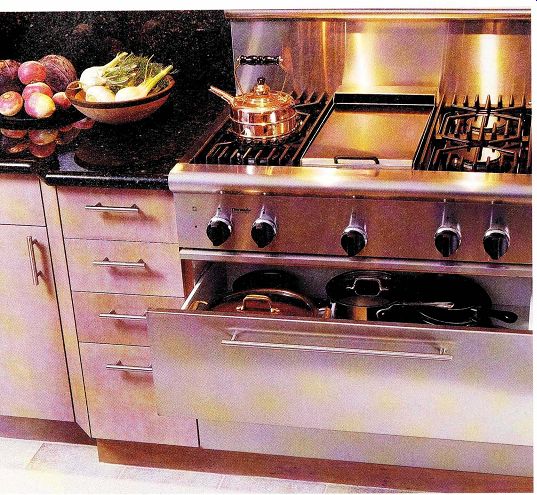
--------------- An almost all -drawer kitchen contains a combination
of narrow, wide, shallow, and deep drawers . The large drawer under the cooktop
provides the perfect storage place for pots and pans.
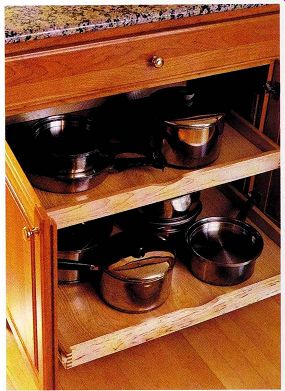
---------- A hybrid of shelf and drawer, this sliding shelf offers convenient
access to pots and pans while keeping them tidy and contained behind a door.
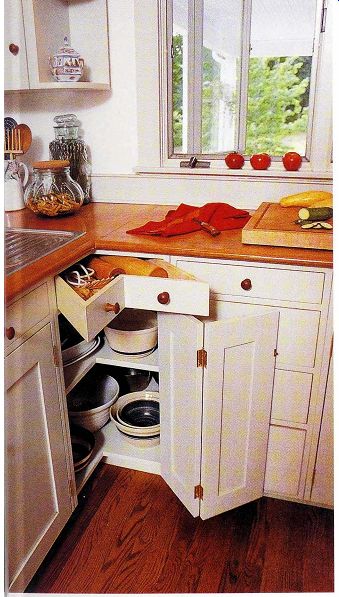
--------- An unusual corner drawer makes good use of a usually wasted space.
Base cabinet storage is handled by fixed shelves and a piano-hinged door.
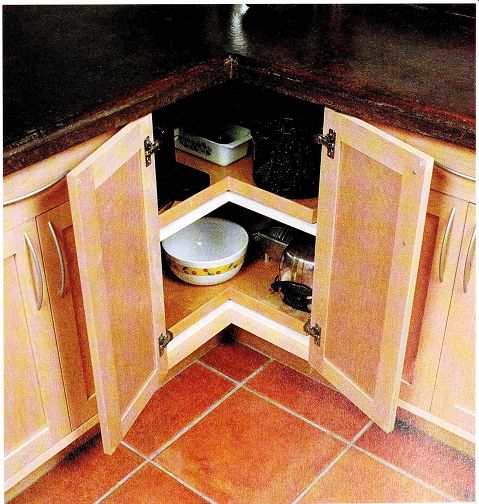
--------- Lazy Susans rank high on the list for making use of corner cabinet
storage.
If the corner is not close to an appliance, there's room to hang two doors that meet at the corner when they close as shown here.
If there's limited clearance, the doors can be joined by a piano hinge.
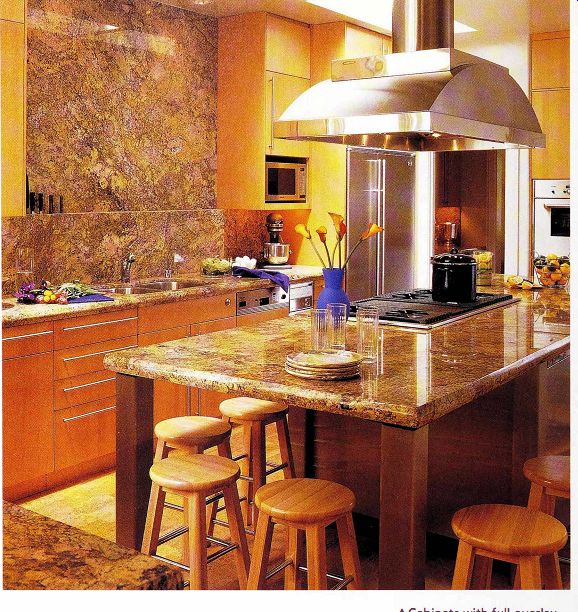
---------------- Cabinets with full-overlay doors are fitted with long
stain less-steel handles, handy for hanging dish towels. Drawers of varying
depths provide versatile storage. Note the knife storage built into the granite
ledge over the sink.
Cabinet hardware ------- Cabinet hardware can greatly influence a kitchen's looks-and its budget. Like cabinets, hardware runs the gamut in costs, styles, and availability. Pulls are the stars of cabinet hardware, and they come in an endless array of designs, from popular bin pulls to wire pulls to knobs and latches. Wire pulls won't snag clothing, they're easier to grasp than knobs, and, if they're long enough, they can double as towel bars. On the other hand, knobs are easier to replace if a kitchen is being remodeled.
Hinges aren't as obvious as pulls, but they shouldn't be neglected either. Concealed adjustable hinges (developed for frameless cabinets but now made for face-frame cabinets, too) allow for easier installation and adjustment than butt hinges. Butt hinges, however, are still the more authentic option for a period kitchen, and they're also less obvious than adjustable hinges in glass cabinetry.
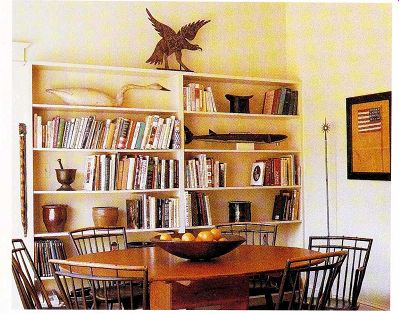
------------ Thin, white shelves display scores of cookbooks in a casual
dining room, along with antique kitchen tools, including stoneware jugs and
a mortar and pestle.

----------- A built-in hutch provides storage space for linens and seldom-used
serving pieces in the closed cabinets below; a dishware collection is stored
and displayed on the open shelves above.

-------------- Custom-made, wood-and-steel shelves make a home for useful
and decorative items.
The unusual, pyramid-shaped shelves are a work of art in their own right. A tiny, metal pouch attached to the wall accents the bottom corner of the shelves, while providing storage space for kitchen scissors.
Open Shelves
In addition to drawers, the Cornell kitchen study applauded open shelves, especially those positioned at eye level and just above and below. Open shelving hung over food preparation areas gives you more room to work than bulky, low-hanging cabinets (or cluttered counters) , as well as a greater sense of openness. And shelves are ideal for storing a whole host of items, from dishes to stockpots to spices. It's important to match the function of the shelf with the design of the shelf, considering size, method of support, material, and finish. While you can store almost anything on a shelf as long as it's structurally up to the task, location should, to a certain extent, dictate shelf size. A good rule of thumb is to keep shelves at head level more narrow than higher shelves and to use them for smaller items, like spices, that only require a few inches to perch on.
Shelves can be as narrow as 2 in. or as wide as 2 fl ., but here are some standard guidelines: Allow 8 in. minimum for cookbook shelves, 12 in. to 15 in. for dishware, and 18 in. or wider for pots and pans. Spacing shelves can be tricky. If you space shelves far apart, you'll be tempted to slack dishes and glasses too high. Better to use more shelves spaced closer together, which makes it safer and easier to access dishes-and everything else , for that matter. Should shelving be adjustable? That's an individual decision, but think about this: If shelving is designed to fit the items you normally store, and if it contains several shelf heights, it's likely that you will never readjust the shelving. And fixed shelving eliminates the rows of holes required for adjustable shelving. Shelves hung at 18 in. to 30 in. above a work space can also double as a mount for task lighting.
Prefabricated shelving is now available in a variety of materials, but wood and engineered wood (plywood, medium-density fiberboard, and particleboard) are still the most popular. If your personal style dictates something less traditional, glass shelving helps achieve a classic modern design (more on that later), and mobile or fixed-wire shelf units are favorites in increasingly popular restaurant-style kitchens.
Wire shelving makes a lot of sense for storing foods like root vegetables and fruit because it allows for better circulation than solid shelves, but you'll have to incorporate baskets or other containers for storing small items that could slip between wires. Plastic-coated wire shelving is widely available and can be assembled by a dedicated do-it-yourselfer, making it very cost-effective, although its humble aspect makes it more suitable for pantries and closed cabinetry than exposed areas.
WOOD SHELVES---Wood and engineered wood shelves are available in a range of styles and prices, making them a practical solution in the kitchen. But if they are asked to carry a heavy load without a proper support system, the results can be disastrous. Wood shelves should be carefully selected according to your depth and width requirements in conjunction with the intended method of support; for instance, you don't want to store cast-iron pots on a long shelf with no intermediate supports. When sturdier shelving is required, brackets can be added at one or more points across the mid-span of the shelf. A cleat, which attaches to the wall and runs the length of the shelf, can be used to help prevent widthwise sag. Additionally, an edge band attached to the front of the shelf provides a considerable amount of stiffness by acting as a miniature support beam (see the drawing on p. 58).
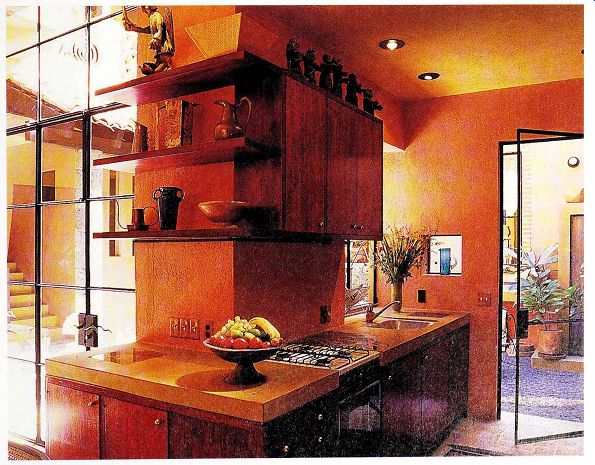
-------- The dramatically cantilevered shelves in this Mexican-influenced
house join the kitchen and dining area and create a bold display niche for
folk art.
-------------
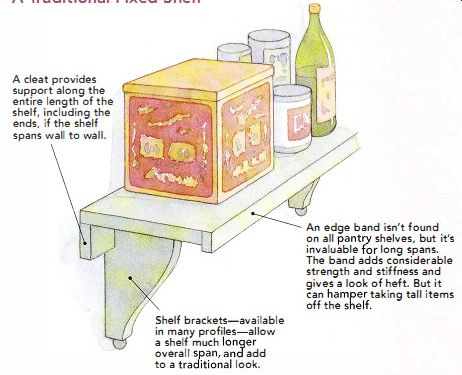
-------- A Traditional Fixed Shelf: A cleat provides support along the entire
length of the shelf, including the ends, if the shelf spans wall to wall.
Shelf brackets-available in many profiles-al low a shelf much longer overall span, and add to a traditional look.
An edge band isn't found on all pantry shelves, but it's invaluable for long spans.
The band adds considerable strength and stiffness and gives a look of heft. But it can hamper taking tall items off the shelf.
--------------
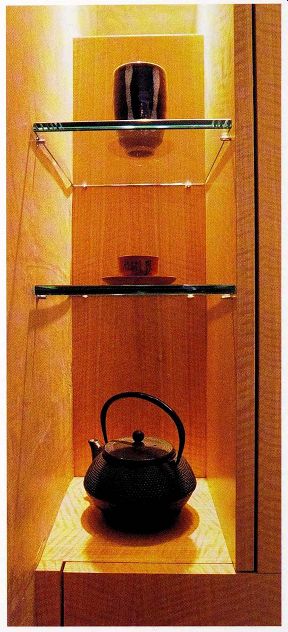
----------- A display niche with chunky glass shelves and dramatic lighting
fills the nook between kitchen and dining area.
Wood and engineered wood shelves can be finished with paint, stain, or a clear or tinted varnish or polyurethane whatever personal preference calls for. On a practical note, however, city dwellers may prefer to use paint on fixed pantry shelves, eliminating any gap between shelf and wall, thus providing fewer hiding places for the wily cockroach.
Just remember that when shelves are freshly painted-gloss or semigloss paint works best-you'll have to wait a while to load up the shelves. Wait at least as long as the paint-can label suggests, and then lay sheets of waxed paper (not plastic wrap) loosely (no tape) on the shelves before stocking them. After a while, slide the waxed paper out. This prevents the paint-stuck-to-the-soup-can problem, and works for all painted and stained shelves.
GLASS SHELVES---While wood may be the most popular material for shelves, glass can be an intriguing alternative, whether for stand-alone shelves or for shelves in cabinetry.
They're particularly suitable for storing glassware and fine dishware that could be overwhelmed by dark and heavy wood shelves. Glass is also a boon in perpetually overcast climates or in rooms without a lot of windows, as it allows light to bounce around.
The edges of a glass shelf figure prominently in its overall look, so edge treatment and glass type should be carefully considered. Standard clear glass actually has a greenish tint, which is especially apparent at the edge; if you prefer a clearer glass, look for low-iron Starfire glass.
Glass shelves can be quite strong, but they have limits: A shelf with a light load and a short span can be a minimum of 3/8 in. thick, but longer spans (over 3 rt.) and heavier loads, such as stacks of plates, require a thickness of 1/2 in. or more.
A glass fabricator or cabinetmaker can recommend the appropriate thickness. And while building codes don't generally require tempered glass in cabinet shelves, it's a good idea to check with your local building department.
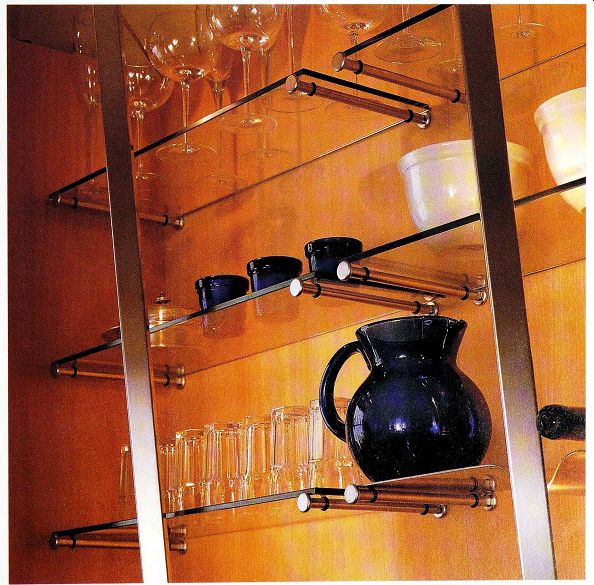
--------- When glass objects are displayed on glass shelves, light gets
a chance to bounce around. These shelves are supported by metal rods (which
reflect light, too) but note the rubber O-rings, which lift the glass above
the metal.
Countertop Storage
A good rule for a hardworking kitchen is to keep countertops clear of as much clutter as possible. That said, the countertop can still provide valuable storage space . According to several kitchen-use studies, a countertop is at a good working height if it comes up to just below your bent elbow (and about 4 in. lower for a pastry surface) . On a countertop situated at that height, you'll use the first 18 in. of its depth comfortably, which leaves 6 in. of potential storage space at the back of the standard 2-ft. countertop. But use the back 6 in. sparingly, because it can be a handy staging area when cooking. Frequently used cooking utensils (in a sturdy jar) and small appliances are good candidates for countertop storage because they don't take up too much space, and having them nearby while cooking makes food preparation a less frantic affair. A narrow shelf-or even two-at the back of the countertop makes a useful addition, providing an out-of-the-way but accessible spot for spices, measuring cups, a kitchen timer, and other small kitchen tools that can quickly clog up a counter.
-----------------------
Remodeling History
Architects Rick and Liz O' Leary bought this 200-year-old cottage in a severely dilapidated condition, but over the last decade they've been nursing it back to life, room by room, as their budget allows.
Their overriding design philosophy is to maintain a historic feel, but to mix it up with a few modern touches. Starting with the kitchen, they knocked out both exterior walls to install double-hung windows and a side door that leads to a new kitchen garden. Rick and Liz then plastered the upper part of the walls and installed wainscoting of wide-board, horizontal panels and ripped off a drywall ceiling to reveal existing timber beams. The last finish task was to replace the wide-board floor, which had been covered with sheet vinyl, and pa int it with a handsome diamond pattern . When the backdrop was complete, it was time to get down to the business of kitchen storage. The O' Learys put months of elbow grease into refinishing several kitchen pieces, including a cast-off restaurant range and a set of old drawers, which they painted dark blue and fitted with new bin pulls that are nickel-plated to match the restored 1920s faucet. They built wall-hung shelf units with adjustable shelves and base cabinets with inset doors, which support the two-bowl, reclaimed porcelain cast-iron sink. Countertops are made of Carrera marble salvaged from a local stone yard, which had mined it from an abandoned, half-built bakery. The finishing touch was two small, rolling metal carts fitted with butcher-block tops that could be wheeled over to the range or out of the way.
This setup worked fi ne for a few years until one, and then two, little boys joined the household. A surge in at-home cooking required a dishwasher and more preparation space. To accommodate both in style, Rick wrapped two knocked-down base cabinets with :X-in. plywood and then applied a face frame with panel molding.
A dishwasher fits into one cabinet while drawers fit into the other.
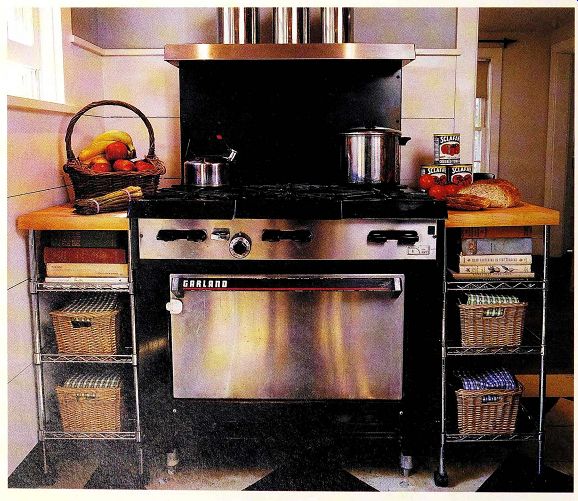
--------- Two rolling, metal carts were fitted with butcher-block tops
for extra prep space.
Wire shelves hold cookbooks, spices, oils, hot pads, and other necessities for cooking.
The carts fit neatly on the sides of this restored restaurant range.
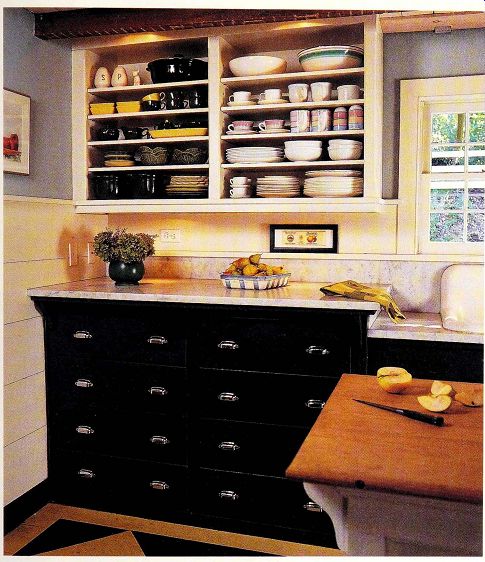
------------ Two sets of beat-up drawers from a 1930s stationery store
were thoroughly restored and fitted with new pulls. Matching cabinetry with
inset doors was built and installed under the restored, porcelain cast- iron
sink .
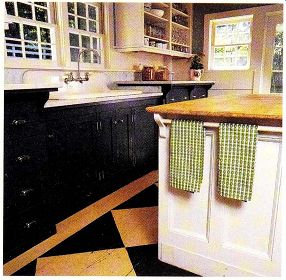
--------- The restored drawers and new cabinets provide a punchy contrast
to the white sink, marble countertop, and wall-mounted shelves.
The newly built island is finished with more elaborate panels and painted a contrasting white. Simple wood towel bars hang from brackets at each end of the island.
----------------
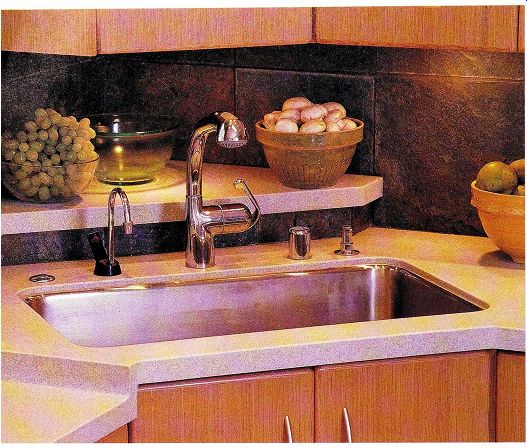
------------- Don't let so-called leftover space go to waste. Here, a niche
behind a corner sink holds decorative objects, but it can do double duty as
temporary storage for fruits and vegetables waiting to be washed, or for a
recipe holder.
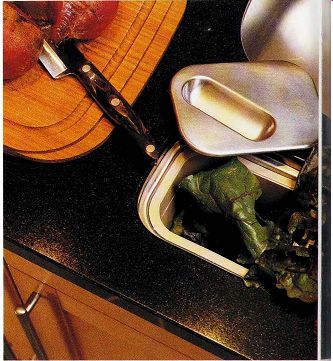
---- A slot in the countertop allows vegetable trimmings to be scraped
directly into a container for composting.
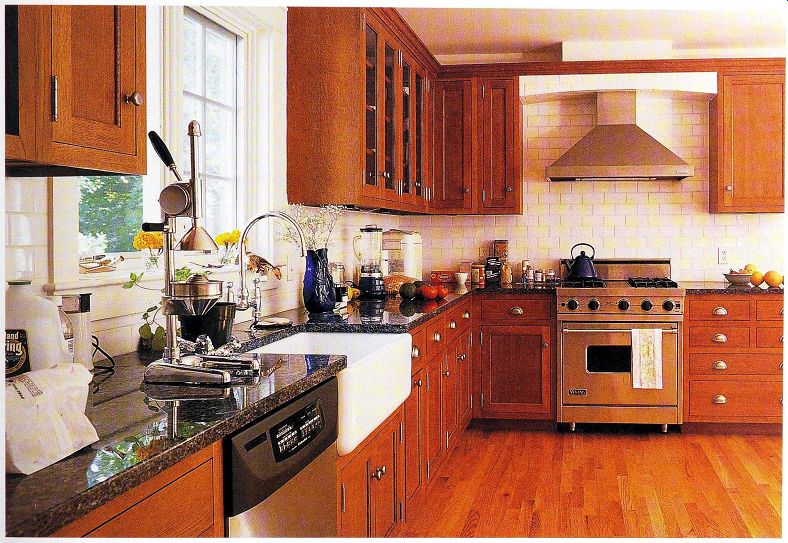
-------- This countertop exposes its real-l ife job of making a home for
appliances, fruits and vegetables, bakery leftovers, and a repotting in progress.
Yet, there is still plenty of room to work .
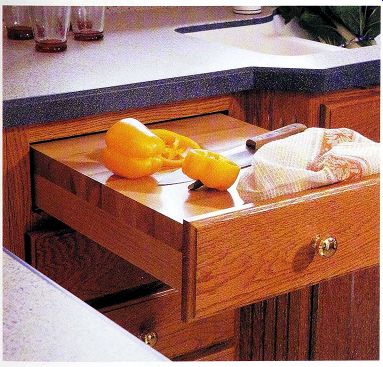
---------- Maximize countertop space by storing a pullout cutting board
in a custom-made slot just under the countertop.
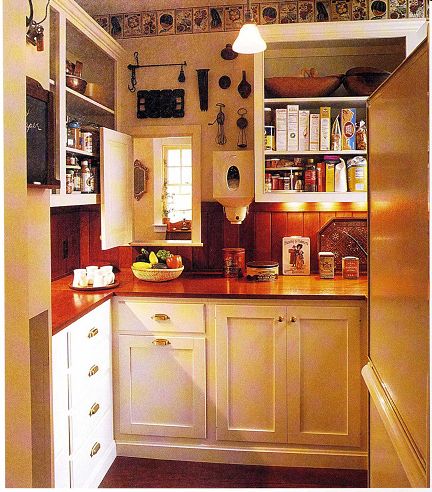
------------ This pantry is practically a second kitchen. With abundant
shelf and storage space, it provides convenient, uncluttered storage for dry
goods and more.
The Essential Pantry
Pantries are necessities once again in the American kitchen as we follow our ancestors' buying-in-bulk habits. Instead of visiting the general store on occasion for barrels of flour and sugar, we're shopping every few weeks at discount warehouse stores, hauling home super-sized bags of dog food and 27-count flats of bottled sports drink. Where to put these bulky non-perishables but in a pantry? A pantry can be any size or configuration. If space is really tight but you still prefer to stockpile items, designate a longer-term pantry in a lesser-used space, such as the basement or even a garage (make sure items won't freeze or spoil from heat), and keep a small stash of items in the kitchen. A standard 2-ft.-deep closet can be converted into a pantry by installing rows of shelves that wrap around the walls. If no closet is available, carve out space between wall studs (avoiding electrical conduit and plumbing, of course) to fit a bookcase-like pantry, with or without doors.
The least efficient pantry arrangement is the standard fixed-shelf setup in a 2-ft.-deep base cabinet with doors or a 15-in.-deep wall cabinet-the food storage method that many of us grew up with (and that our parents cursed) . If you must use a base cabinet, install pullout shelves. A similar option is pullout pantries, which are available prefabricated or which can be custom built. Pullouts use space quite efficiently because they neatly fit in spaces that are too small to accommodate a standard cabinet, and when the pantry is pulled out, it's easy to see all the items it contains. It's important to make sure, however, that the slides-the hardware that the pantry glides on-can handle the weight of the fully extended pantry shelves.
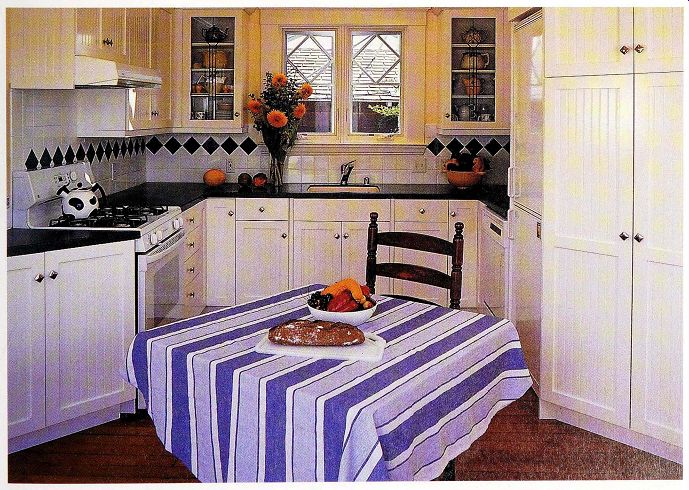
------- Squeeze in storage space, but not at the expense of comfort. This
tiny kitchen is actually twice the size it was, but the designer refrained
from boxing it in by making the end cabinets triangular.
This opens up the kitchen to the table and actually provides the proper shallow shape for pantry storage.
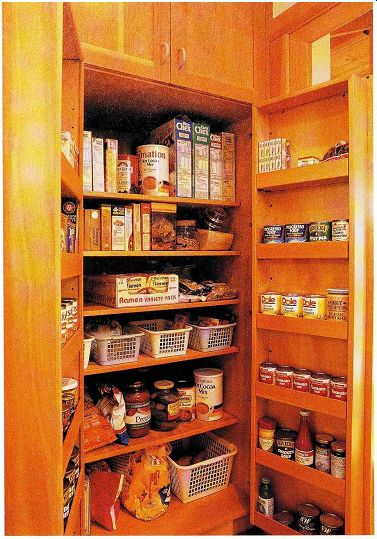
------- The narrow double doors on this pantry provide the perfect space
for canned goods and condiments. Small plastic wire baskets hold soup mixes
and flour; a larger one holds potatoes.
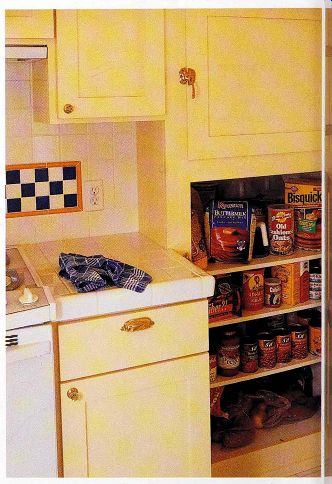
------- Pantry storage in a cabinet next to the oven features a traditional
thumb-turn latch and surface-mounted hinge.
It's a fine location for a pantry in a small kitchen-close, but not adjacent to, the cooktop.
--
Cabinet manufacturers also offer fold-out pantries, which include several vertical layers of narrow shelving. These can hold a lot of food, but they're relatively expensive, require a fair amount of widthwise space , can be slow to operate, and require a lot of forethought in the arrangement of items to ensure that none get lost or forgotten. A step-in pantry built on site can fit in the same amount of space for a much smaller price tag. Of course, the walk-in pantry is the queen of pantries, and if you can afford the space, you won't regret having one. Use an assortment of baskets, tins, or wood boxes inside a walk-in to store small items more efficiently, and a small table or countertop makes a useful addition as it can perform double duty as a secondary work space or makeshift bar.
Pantry shelves should be wide enough to hold one to four items front to back but narrow enough so that you can see what's on the shelves easily. Shelves around eye height should be no wider than 12 in. and can be much less, de- pending on the size of the pantry and what's being stored.
Lower shelves can be deeper--even 20 in.--for bulkier items. Take a cue from the grocery-store stockers and stack items front- to-back first and then side-to-side.
Whatever style of pantry you have, make sure it's well lit.
Pullout pantries are illuminated by general kitchen lighting, but a can of soup can be easily lost in the gloom of a multilayer foldout pant ry. A small light fixture that comes on when the door is opened can be installed in these units. A hanging or wall-mounted fixture works best in a step-in or walk-in pantry because it will evenly illuminate all (or most) of the shelves; a compact fluorescent bulb provides the best combination of economy and looks , and it gives off less heat.
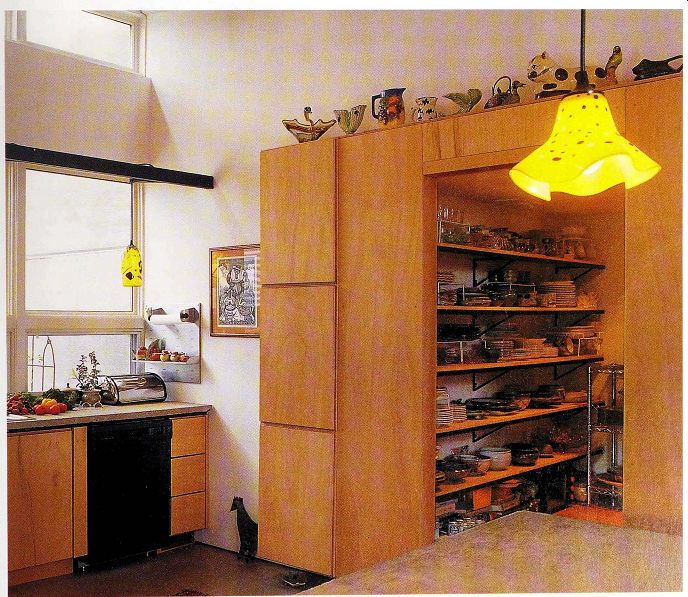
------------- This pantry is the center piece of a large opening that's
framed by sleek cabinets.
The walk-in pantry holds dishes on one side and food on the other. Shelves are :3/4-in. plywood with edge-to-edge black-metal brackets.
Storing Kitchen Gear
It doesn't matter if you store a pot in a cabinet, on a shelf, or on a hook. What really counts is storing it close to its point of use and making it easy to retrieve, use, and put away. Ideally, this applies to everything stored in a kitchen.
Pots and pans should be stored near the cook top, baking sheets near the countertop where you make cookies, and dish ware next to the sink and dishwasher. Cooking tools can be sorted in drawers located near the stove, or they can be stored out in the open in crockery or on hooks. It's good to keep in mind, however, that anything stored out in the open is going to gather dust and grease if it isn't used and washed daily. It's also good to keep in mind the laws of gravity; when loading shelves or cabinets, place heavier items below lighter ones.
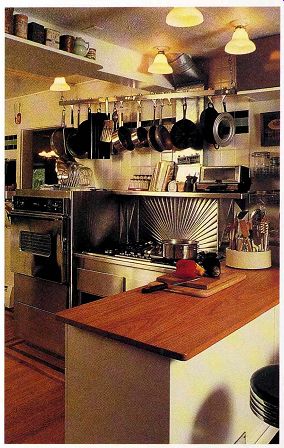
------- A lively kitchen for a serious cook has much of its storage out
front-on pot racks, in big drawers, and on shelves tucked wherever possible.
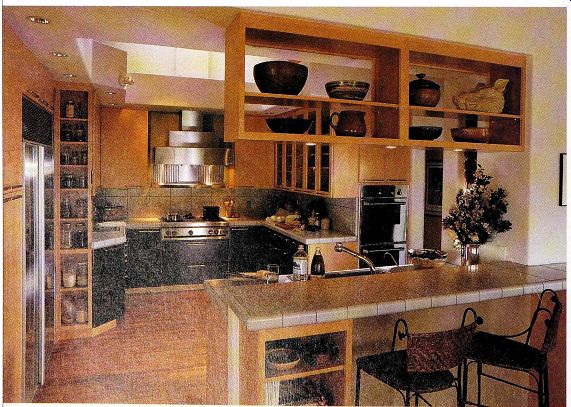
------- Built- in storage in this kitchen provides visual variety, pairing
light wood wall cabinets with dark, plastic-laminate base cabinets, open shelves
with doors, and wide shelves with a vertical stack of narrow shelves.
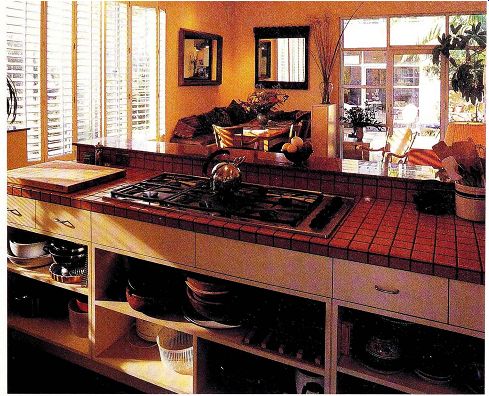
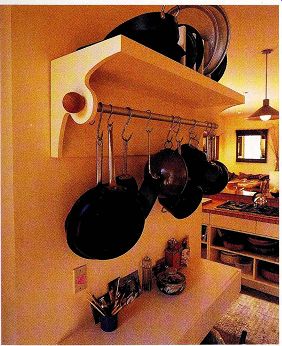
----------- An urban house/art studio in Oakland, California, has a kitchen
designed for a couple of cooks, and a living/ dining area designed for a group.
Shelves under the cooktop hold bowls and other kitchen gear, while pots and
pans are stored on a rack.
Pots and Pans
Store pots and pans according to their use first (are they used on the range top or in the oven ?) and then by shape and size. Stockpots, pasta pots, and other big pots go together, saucepans together, saute and frying pans together, and baking pans together. Among baking pans, stack round with round, square with square , rectangular with, well, you get the picture; pot lids can be stored in slot ted racks or on hooks, just not on the pots themselves. More shelves with fewer items are a much less precarious (and annoying) option than one towering stack of pots and pans.
Pot racks
Pot racks can be an appealing alternative to cabinet storage, particularly if you're a gear-head and enjoy viewing your collection. A pot rack belongs near the stove but not right over it, unless you like cleaning grease from pots you haven't even used. It's better to hang the rack over a nearby countertop or over an island, just as long as it's only a few steps from the cooktop. If the rack is hung over a work space, coordinate it with overhead lighting so that it doesn't cast annoying shadows. And another thing to consider-pot racks can't be hung on sky hooks, so before you get your heart set on a spot, make sure there are accommodating ceiling joists or wall studs. The height of the pot rack will depend on how far you can comfortably reach to take a pan off the rack safely, and to hook it back on.
Baking sheets and trays
Storing trays and cookie sheets horizontally in stacks can make anyone give up and order out. A combination of the nesting instinct and gravity take hold of the stack, making it hard to grab just one pan and slide it out. Small slots that hold one or two trays are an improvement, but the best storage method is a series of vertical slots that hold a couple of trays or sheets apiece.
A good place for this type of system is on top of the refrigerator, positioned flush with the front of the fridge, so it's easy to reach and doesn't get blocked by other items.
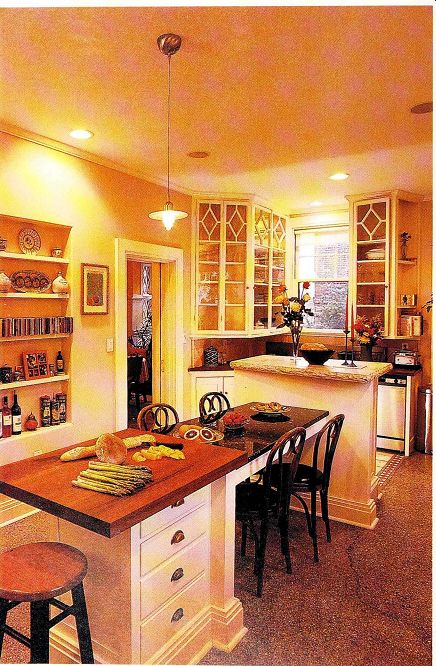
---------- Rather than relegate the breakfast table to a corner, this kitchen
makes it the centerpiece. The low table is also the perfect height for rolling
piecrust and kneading dough.

------- Slots above the preparation sink are fitted with tea k slats that
allow pans to drain into the sink. The pans remain in the slots until they
are used again.
Cooks' Kitchens
YOU can recognize the kitchen of an enthusiastic cook by the way cooking gear rules the roost: Tools are stored in jars on the counter or hung near the stove, pots are within easy reach, and cabinetry is designed to perform specific functions.
These two kitchens are true cooks' kitchens with well-devised storage. In both kitchens, the cook's life is made easier by open shelves and slots for pots, plenty of rods for dish towels, and convenient storage for kitchen tools located where they are used or cleaned. In the white kitchen, space over the sink is fitted with teak slats that keep pans at the ready for cooking, while also serving as a dish rack. In the cherry kitchen, the backsplash is filled with shallow shelves that hold small appliances, spices, and bowls--a perfect setup for mise en place, the culinary term for making sure all ingredients and tools are ready before cooking. And in both kitchens, well-placed shelves make the most of storage space without interfering with the rooms' flow. In the white kitchen larger structures, like the breakfast table and pantry, are incorporated into the kitchen's active work space; they are both functional and attractive, which creates a hardworking, but still handsome, room.
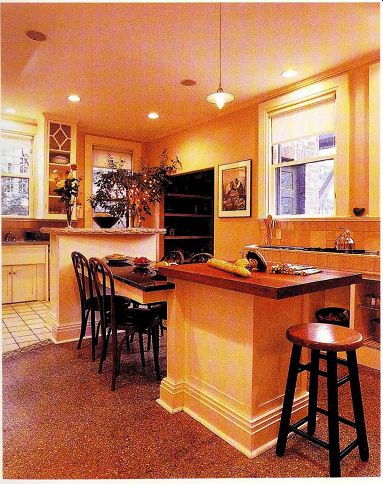
-------------- A pantry that gets plenty of use needs no door, like this
one that adds a point of interest and easy access.
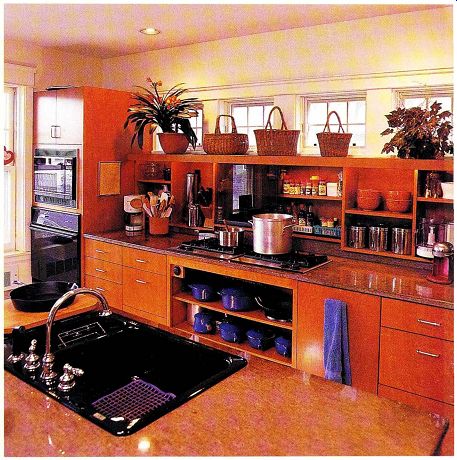
------------ Abundant shelves situated above and below the counter keep
this kitchen uncluttered and operating smoothly. This smartly designed shelving
unit stops short of the ceiling, which creates a display area for plants and
baskets and doesn't block the windows behind it.
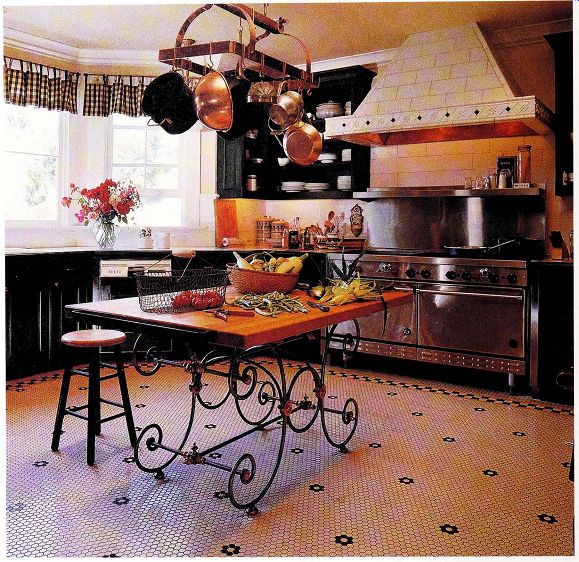
------------- This colorful pot rack, which floats over a dainty legged
island table, makes a bright counterpoint to the colossal range and dark cabinets.
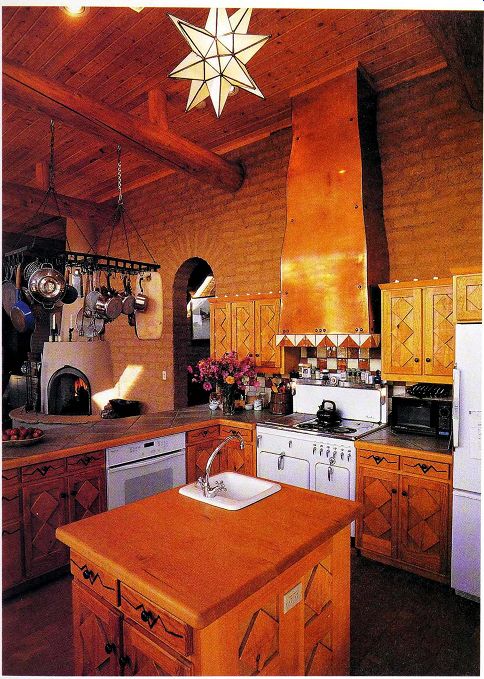
------- In this kitchen, most appliances and utensils are stashed in drawers
and on shelves. But the pots and pans are perfectly situated on this rack,
which is within easy reach of the stove but away from its grease and dust.
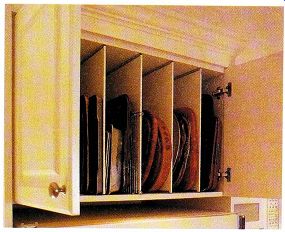
------------ Storage for flat objects, such as trays and baking sheets,
is easiest to access when it's vertical-in this case, over a refrigerator.
The cabinet extends to the refrigerator's edge so that nothing can be stashed in front of it.
Another option is to outfit one of the leftover spaces between base cabinets (ideally next to the baking or food-prep area) with vertical slots, which makes great use of otherwise wasted space. Wherever the unit is located, consider the pros and cons of a door: For fast access and restaurant-style charm, leave the slots open, but if you don't use baking sheets frequently, specify a door to keep the space dust-bunny free.
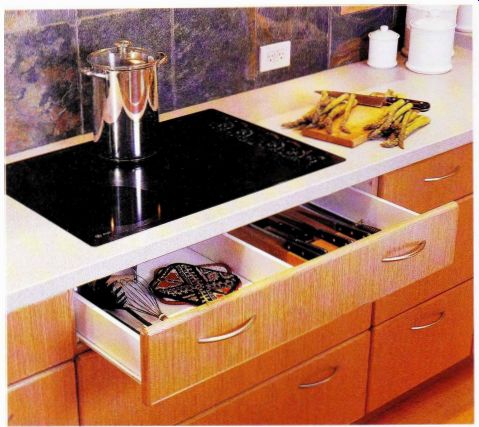
------------ An all-drawer kitchen features light wood with retro metal
pulls. Shallow drawers handle knives and other cooking tools, while deep drawers
carry heavy items-pots and pans-or bulky items, such as linens, or all those
plastic odds-and-ends that seem to accumulate.
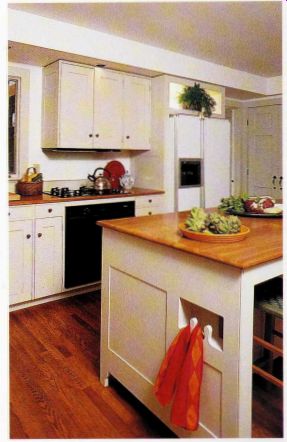
----------- A fanciful cutout on this island makes stashing or retrieving
a dish towel quick and easy.
Small Tools
Avid cooks tend to prefer storing their cooking tools close at hand so they're easily retrievable. Tools on display are also a pleasure both for their beauty and for the sheer joy of ownership. (Who wouldn't want a rack of copper pots-and someone to clean them?) It costs much less to store tall, slender tools, such as wooden spoons and spatulas, in a heavy crock placed on the counter rather than in a custom-made drawer for the same number of tools. Plus, they're handier on the counter; it takes only one movement to grab a spoon from a jar versus three movements to retrieve one from a drawer-open drawer, rummage, grab tool. Tongs in particular are a nightmare to keep in a drawer, and they can even get tangled in a crock; if you use them often, you might consider storing them on their very own hook.
An Abundance of Hidden Storage
This kitchen has a wealth of storage in a variety of guises. The continent-sized island handles a tremendous amount of storage with face-frame cabinets and inset doors and drawers, while perimeter cabinets against the wall have flush overlay doors and drawers. Throughout the kitchen, super-long hand les double as dish-towel racks (but only on cabinet doors, as the towels would interfere with drawers). Three of the aluminum panels at the backsplash flip up to reveal an appliance garage fit for a four-star chef. The countertop has a full 2 ft. of clearance here, with the appliance garage recessed into the space behind the kitchen wall.
To brighten both cabinet contents and the kitchen itself, wall cabinets near the breakfast table have glass-door fronts and windows for backs, and all the other wall cabinets are fitted with halogen puck lights on top.
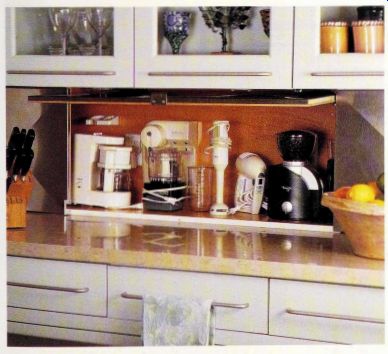
-------- Diner-style aluminum panels flip up, revealing a super-deluxe
appliance garage.
An outlet in the back keeps cords out of the way.
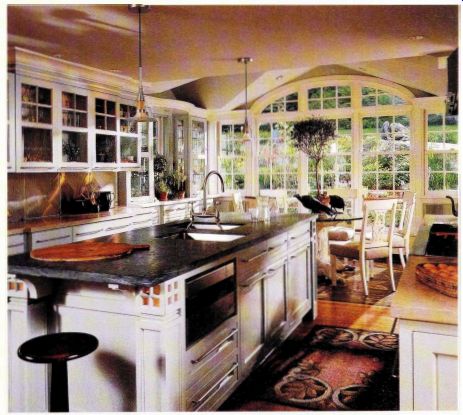
---------- With appliance garage doors closed, the kitchen is a bright,
serene space with volumes of storage and no clutter in sight.
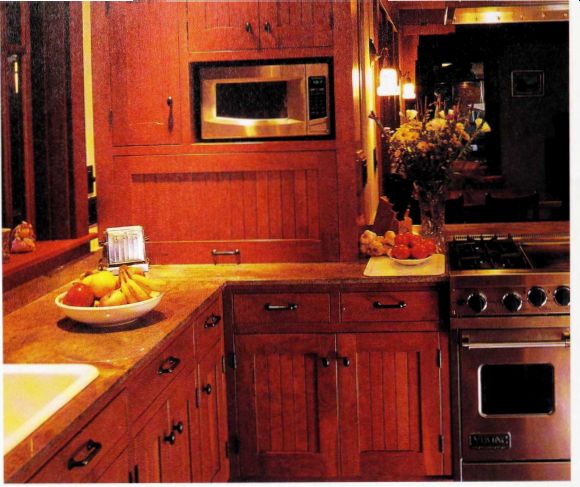
----------- An extra-wide appliance garage under the microwave salvages
counter space in this kitchen, which was remodeled in the style of Greene and
Greene, hence the super-wide cabinet frames.
If you prefer a pristine, minimalist countertop (or for smaller tools that would get lost in a jar) , designate a shallow drawer for tool storage in the vicinity of where they'll be used. The drawer should have enough dividers to keep like sized tools aligned, but over-customizing it with molded slots for every tool will backfire. Put ting away utensils will turn into a shape-sorter toy-fun for a preschooler but a headache for a busy cook. It's also wise to have a couple of hooks near the oven for hot pads and a rod near the sink for dish towels. Extras can be stored in a drawer or bin nearby, perhaps with other essentials like storage bags, aluminum foil, waxed paper, and plastic wrap, which should be kept within easy reach of the food preparation area to make food storage and cleanup a breeze.
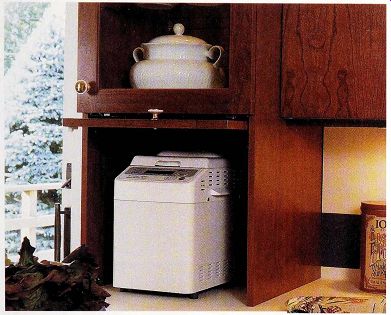
----------- This "one-car" appliance garage is just tall and wide
enough for the bread machine, which is the largest of the small appliances
and notoriously tricky to store.
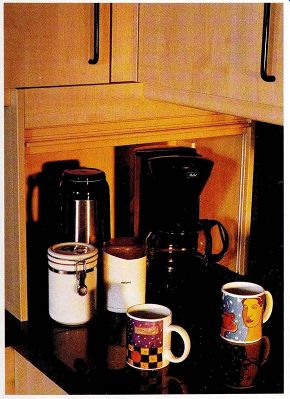
------------ A standard-sized appliance garage creates a coffee-making station
with everything you need at hand-a certain blessing first thing in the morning.
Small appliances
Small appliance storage should follow the same guidelines as all other storage. It doesn't matter whether you choose to store small appliances in the open or in a cabinet as long as they're easily accessible. The coffee grinder can find a comfortable home in a wall cabinet or on a shelf above the coffee pot, depending on which space works best in the layout of your kitchen. One thing to keep in mind, however, is that frequently used appliances should be kept at eye level or below-it's unsafe (and inconvenient) to store them too high.
There are those of us who love to see certain appliances in a permanent place on the countertop, even if they take up useful space and collect crumbs and dust. If you are attached to the looks of a stand mixer, just find a quiet corner for it. And if you find it more convenient to keep most small appliances and other kitchen gear out in the open, consider 30-in. -deep countertops. (Cabinets that deep may not function well, aside from being extra expensive, so simply have the cabinets pulled out from the wall 6 in. and use that dead space for conduit or plumbing if needed. Any exposed cabinet sides will need an extra-deep panel to cover the gap.) Some cooks prefer to stash small appliances in an appliance garage that is, so to speak, on grade with the countertop. While it, too, takes up counter space, a garage keeps appliances cleaner and more contained so that they don't spill out into your work space. Even small appliances that are used daily can be stored conveniently in an appliance garage-just don't park items in front of the garage or the stored items will be hard to back out. Whether you store appliances on the back of the countertop, in an appliance garage, or in a pantry, it's important to make sure you designate enough room for the tallest, a blender or bread-making machine, for instance.

---------- Shallow drawers work best for cutlery and flatware because there's
less opportunity for tangling. On the left, there's a concealed lower level
perfect for seasonal utensils like ice-tea spoons and lobster crackers.
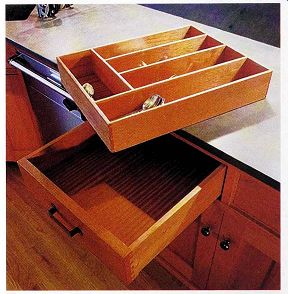
-------- A Craftsman-style drawer and its flatware insert were designed
with characteristic dovetail corners-a handsome and sturdy detail.
Silver, Flatware, and Knives
Flatware or silverware stores nicely in drawers that are 4 in. to 5 in. deep. If you're purchasing custom-made cabinets and your cabinetmaker offers divided trays, opt for removable inserts, which allow for easier cleaning, and stackable trays, which provide a good spot for extra place settings. If you have oversized flatware or silverware, make sure the cabinetmaker is aware of the size slots or partitions required. Divider trays are widely available in home stores, too, but remember to test your own settings to make sure they fi t before you buy.
SILVERWARE---- Cabinetmakers may offer silvercloth-lined drawers for storing silver, either with slots for each piece or compartments for groups of pieces. Additional, loose storage cloths will come in handy as well. Silvercloth, which traps the airborne chemicals that tarnish silver, is also available by the yard if you want to line an existing drawer. (Don't use glue containing sulfur, which tarnishes silver.) In addition to silvercloth, drying silver immediately after washing it will go a long way to prevent tarnish.
KNIVES -- Safely is a prime concern with knife storage, and that includes storing them in a manner that doesn't dull the blade-a dull knife resists slicing and can easily slip. And even though Julia Child uses a magnetic strip, this isn't an ideal choice for storing knives because it exposes knives to moisture and hasty, careless handling, which can damage the blade. Slots in the back of a countertop and slotted butcher-blocks are much safer methods, although some chefs claim that poking a knife into a slot can dull the blade, and a blade that chews its way through the block can scratch the countertop. It's also nearly impossible to thoroughly clean a butcher block. The safest method of knife storage is a lockable drawer fitted up with a shallow, slotted wood block. A knife is slipped into the slot smoothly along the whole blade rather than point first.
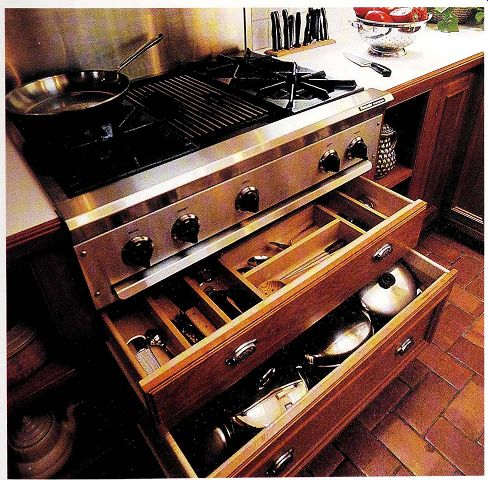
------------ A shallow drawer below the cooktop handles tools, while a deep
drawer holds pots and pans. A knife slot is built directly into the countertop
for handy and safe storage-the blades run down behind the open shelving below.
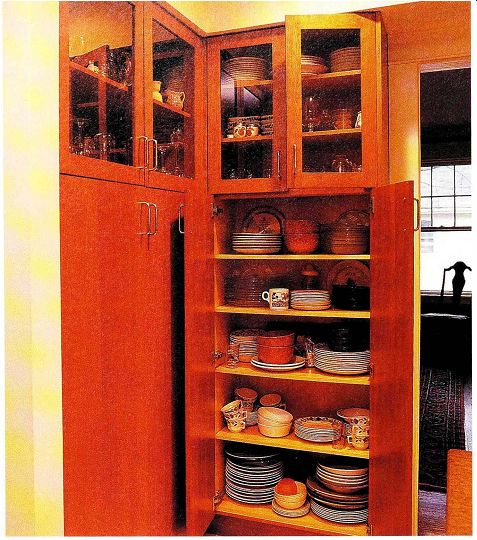
------------- Dish storage to die for: two cabinets with doors and shelves
and two with glazed doors hold an abundance of dishes and glasses.
The cabinets are positioned in a corner of the kitchen, next to the serving countertop and on the way to dining.
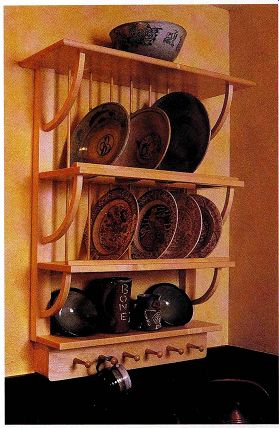
----------- Plate racks are available off-the-shelf in several styles,
or they can be custom-made in any size and style you'd like. This rack has
graceful curves and a row of pegs for cups.
Storing Dishes and Glassware
Dishes and glassware obviously have more eye appeal than soup cans (for most of us, anyway), so these are the items to show off in the kitchen. Cabinets with glazed doors frosted for a subtle look and clear for dishes that always look great and stack neatly--are a great option, or even cabinets with no doors at all. Particularly at tractive collections can be stored on open shelving separate from the cabinetry to create a showcase effect. Even everyday dishes can benefit from open shelves, especially if they're within reach of the dishwasher, which will make unloading the beast a much less painful task.
Freestanding hutches and china cabinets provide at tractive and safe storage for fine china and fancy serving pieces.
Incorporating adjustable ceiling spot lighting or cabinet lighting will highlight your collection and make it easier to retrieve what you need. Cabinet lights can be switched on remotely or designed to turn on when you open the cabinet. Even though they're not the most glamorous members of the kitchen, base cabinets can benefit from lighting as well. Anyone who's ever muttered a silent oath while blindly searching through a deep base cabinet for the turkey platter knows that installing a door-operated light is a true blessing.
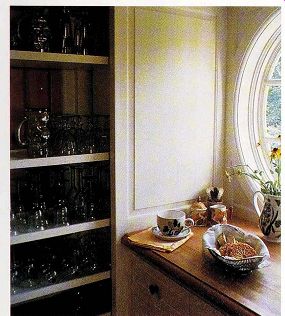
----------- An unusual, round window invites light into this kitchen,
highlighting the adjacent shelves.
Because they're on open shelving, the glasses are stored upside down to deter dust. The shelves have been placed at different heights to accommodate everything from petite wine glasses to hefty beer steins.
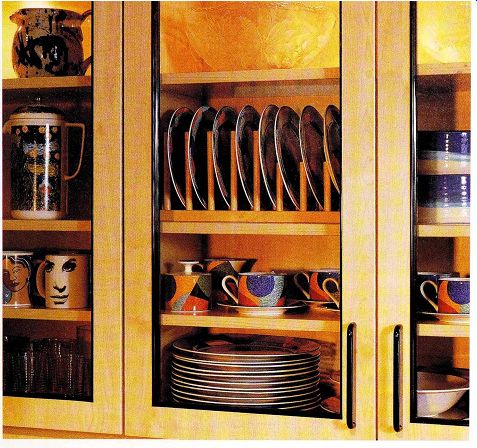
---------------- A bright collection of dishes deserves to be seen, and
these cabinets sport glass doors and halogen lights, perfect for displaying.
Plates find a haven in a built- in rack.
DISHES --- Even if space is limited, try to avoid stacking different types of dishes together, luncheon plates on top of dinner plates, for instance. Various types of plates and bowls are needed throughout a family's day, and there's a higher risk of breakage when you have to pull something out from under a stack; storing the same size dishes together in a single stack is the safest and most functional option. The same goes for storing everyday dishes and their more formal cousins. Cramming fine dishes together with the workhorse variety is a recipe for disaster. Fine dishes and serving pieces should get their own home far away from the hurried hands of a busy family, and you can further protect them from chips and scratches by stacking them between layers of felt, soft foam, a special plate pad, or even a paper towel.
Glasses
Glasses do well in both open and closed storage units, but they require different care, depending on where you put them. Glasses stored in open cabinets or on open shelves will collect dust unless they're stored upside down.
Regardless of storage location, stacking glasses should be avoided if at all possible, but if you must, these guidelines will keep accidents to a minimum. For straight-sided glassware, place one glass upside down, and stack the second right side up on top of it. In the case of tapered glasses, stack no more than three inside each other, and avoid stacking a warm-from-the-dishwasher glass inside a cold glass-it may be difficult to extract later because the warm glass swells. It's fine to hang everyday teacups from hooks and even to stack them, but finer china will fare better if set singly on a protected shelf.

------------ This dishwasher drawer requires no bending over to load.
At half the size of a standard dishwasher, it makes sense for small families
who would either waste water and energy on a half-full standard dishwasher,
or who would have to wait several days until the washer was full before running
a load.
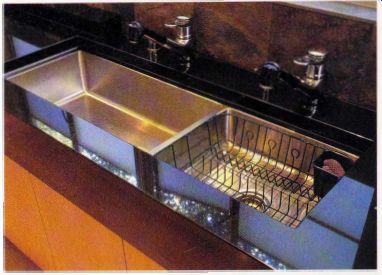
---------------- This sink is a cook's dream, with plenty of room to wash
vegetables and stash a good-sized wire drainer-no throwing high-quality cooking
gear in the dishwasher in this kitchen .
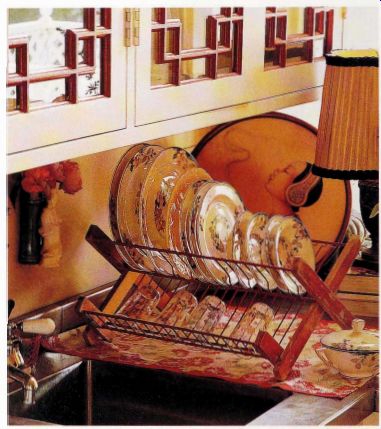
------------ Unpretentious but attractive, this dish-drying rack simply
rests on a stainless-steel counter covered by a pretty dish towel; Arts and
Crafts style glass cabinets above hold dry dishes.
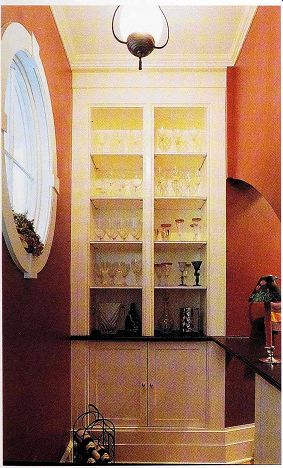
------------ It doesn't take much floor space to build a modern-day butler's
pantry; this one benefits from a large, round window that lights up the collection
of glassware. A hinged, narrow shelf between the pantry and the dining area
makes a perfect sidebar.
Drying Space for Hand-Washed Dishes --- It's rare to see a plastic-coated wire dish drainer with a plastic drain board on a fancy kitchen tour or in a home-design publication (though you'll find a few bold examples in this section) . But look under the sink and you'll probably find one--it's a rare kitchen, no matter how fancy, that doesn't require a place to drain dishes and pots. Paper towels strewn across the countertop aren't an ideal alternative from an aesthetic or practical point of view, especially considering the variety of at tractive dish-drying racks and drain boards on the market. Some racks are simply decorative and the slots aren't actually wide enough for dishes, odd as that may seem, so take a few dishes to the store for a trial run. It's ideal to sit the drying unit in one side of a two-bowl sink, but if that's not an option, situate the rack and drain board on the side of the sink, and al locate a hidden space for it when not in use, Or gel one that’s as aesthetically pleasing as it is necessary and embrace the notion of beauty born of functionality.
A butler's pantry If you entertain frequently and have enough space, consider storing glassware and dishes in a butler's pantry, a common feature of large and modest 19th- and early-20th-century homes . This space , positioned between kitchen and dining room, contained cabinetry and countertops. Food was plated here, and dishes, glasses, and serving pieces were washed and stored here , often in glass-front cabinets. Table linens and large serving pieces were stored in base cabinets fitted with drawers or shelves.
Fragile, expensive china, crystal, and silver were never allowed in the hot, dusty, greasy environment of the strictly utilitarian kitchens of yore but were housed solely in the butler's pantry under close supervision. Despite the modern trend of large eat-in kitchens, the butler's pantry can still be quite useful, offering a wealth of backup storage and work space, as well as a shield for dirty dishes during a dinner party until the butler (that's you, dear) arrives to wash up.
Storing Foods
Just take a good look inside your cabinets and pantry.
How many brands of cereal do you see? Then count the shapes of pasta, types of cat food, bottles of barbecue sauce and sesame oil. And so forth. While our forefathers merely stored huge quantities of a few items (barrels of apples, cellars-full of turnips) , we have huge quantities of a mind boggling variety of items. How we store them can contribute greatly to the sanity of a household. It's ideal to store like items together, but if you have a year's supply of soft drinks, store a few cans in the kitchen and the balance in bulk storage wherever you can make room. Store bulk items in a built-in pantry next to the kitchen , in a designated pantry section of a cool, dry basement, or even in a temperate garage. A skilled grocery-store bagger separates cold foods from dry goods, which is a good rule of thumb if you're packing your own, because it's easier to unload and put away once you get home.
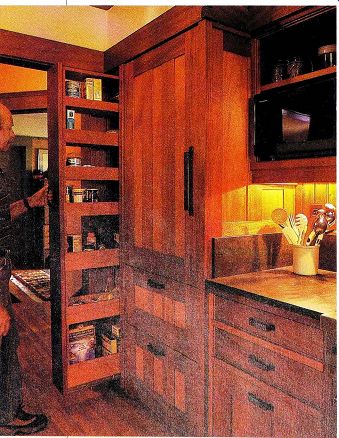
------------- A pullout pantry next to the refrigerator and cooktop provides
instant gratification to a cook.
--------------
Storing Food Safely
• Cool temperatures keep even nonperishable foods fresher, so in an ideal world, they will be stored on the north side of the house, perhaps in a pantry with an operable window that ca n chill the room, if necessary. In any case, keep foods away from the heat sources, like cooktops and wall ovens, and provide ventilation, if possible.
• Onions and potatoes should be stored in ventilated containers but not together because rot may settle in faster.
• Shelled nuts and whole grains should be stored in the refrigerator unless you've got a super-cool pantry or cellar (less than 50°F).
• To reduce the chance of infestation by food pests, flour, rice, other grains, and beans should be repackaged by funneling them into jars that can be tightly sea led. Pastas, crackers, and cereals packaged in cardboard can become infested with larvae if they sit for several months, so do a bug check occasionally, and write dates of purchase on items that will remain in storage for a long time.
• Oils should be stored in tightly closed containers away from light (store nut oils in the refrigerator).
--------------
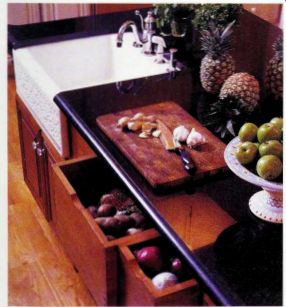
-------------- Potatoes and onions will spoil quickly if stored
together, so simply store them in separate drawers or containers, preferably
in a cool spot.
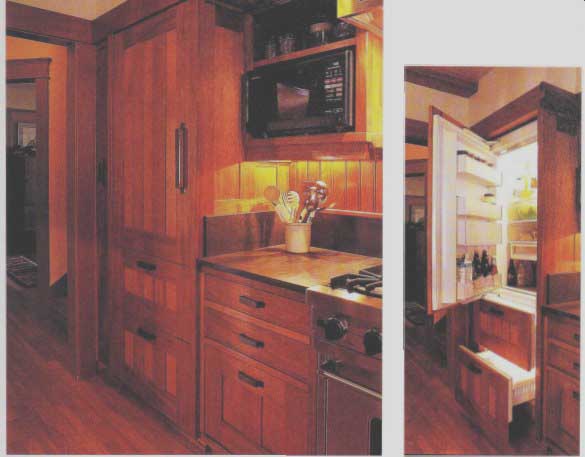
------------- This refrigerator, finished in rich, Craftsman-style mahogany
panels, has the typical shelf and door storage inside.
Below are two freezer drawers with matching mahogany panels. Dividing the freezer in this manner makes the unit less bulky and more accessible.
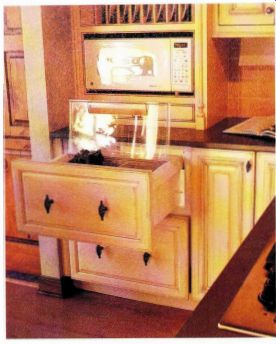
----------- These refrigerator drawers were installed under the microwave
so that produce would be close to the food-preparation countertop.
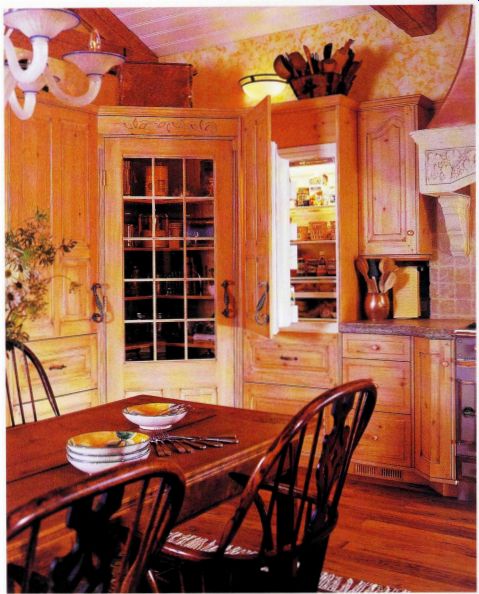
--------------- A freezer and refrigerator don't have to be joined at
the hip. In this setup, they are separated by a corner cupboard. Additional
refrigerator drawers are located beneath the units and are tempered to handle
the specific needs of produce and dairy products.
Storing Cold Food
The refrigerator is a major player in kitchen storage, both in terms of what it stores and how it looks, but it doesn't have to throw its weight around anymore.
Over the past decade, refrigerators have slimmed down, split off from their freezer siblings, and donned the trappings of upscale cabinetry, although there will always be a small but fanatical following of advocates for the rough-and-tough, restaurant-style behemoths. Today's refrigerators look different on the inside, too, with more compartments and individual climate controls for various foods and shelves that can be adjusted-even when loaded with food-or flipped up and out of the way to handle unusual space needs, such as chilling a few bottles of champagne. Your individual needs and habits will dictate which model will be the most efficient in your kitchen.
The basic refrigerator/freezer types haven't changed there are the top-mount freezers, the bottom-mount freezers, and the side-by-side units. The side-by-side is the least energy and space efficient, and you may find the narrow refrigerator shelves frustratingly limited, but they make it easy to install water and ice dispensers, and the narrow doors interfere less with kitchen traffic. The latest versions of side-by-side refrigerator/freezers may have solved the "no-room-for-a-platter" problem by making the refrigerator wider at the top (doors are offset to accommodate the different widths) . Perhaps because it is generally more expensive than the top-mount freezer model, the bottom-mount freezer unit is the least common of the three, even though it's the most energy efficient and the easiest to access since you're in the refrigerator much more often than the freezer. And as we've discovered with cabinets, drawers can be more practical than doors and shelves, because it's easier to pull out the drawer and bend over than to squat and rummage blindly for the ice cream. Some models offer two freezer drawers, which helps organize food storage even more.
Refrigerator/freezer units can be freestanding or built in.
Freestanding models are usually deeper (because the compressor is on the back) and less expensive than built-ins.
Many companies are making shallower, freestanding models to suit the preference for slim-refrigerator styles with a more modest price tag. It's possible to outfit a freestanding refrigerator with cabinetry for a built-in look, but it's important to allow breathing room around all three sides to vent the compressor. It's also possible to embellish a freestanding fridge itself with panels that match the cabinets, or you can choose a contrasting material, such as stainless steel. (Remember that standard refrigerator stainless steel won't hold magnets, so request high-ferrous steel for storing snapshots and kid art on the fridge. An easier, neater route is to designate a space in the kitchen for a corkboard or magnetic board .) Built-in refrigerator/freezers are shallower than their chunkier, freestanding relatives, so they fi t seamlessly into the standard, 2-ft. -deep run of cabinetry. They are taller, too, because the compressor is usually located on top, which requires a ventilation panel.
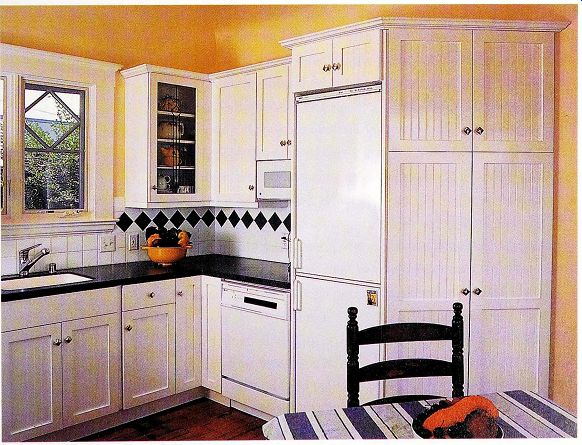
------- In this tiny (91 sq. ft.) kitchen, the refrigerator is encased
in a pantry unit for ultra-efficient use of space.
The refrigerator is a small and energy-saving unit made by Vestfrost (since renamed Conserv), which uses very little electricity and has two compressors, one for the refrigerator and one for the freezer, so both spaces don't have to be re-cooled when one door is open.
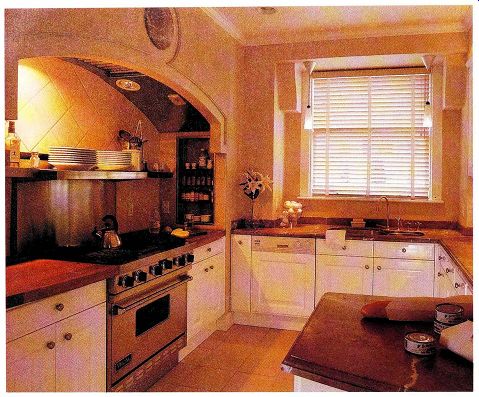
----------- A gently curving alcove contains a range, lots of unencumbered
work space, and convenient spice storage. Taking a cue from restaurant kitchens,
it even has a warming shelf for plates .
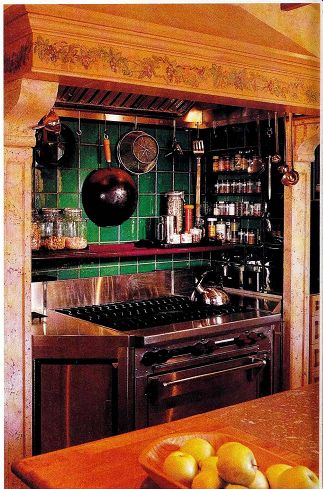
------------95 This cooking alcove, devised of steel and green tile, keeps
everything the cook needs close by. The spice rack's vicinity to the stove
is fine for small amounts of frequently used spices, but bulk storage should
happen elsewhere-preferably in a cool, dry place.
Like built-in refrigerator/freezer units, the latest refrigerator and freezer components are built-ins and can be finished to match or contrast with the kitchen cabinetry. Refrigerator drawers are relatively pricey, but they make a lot of sense . You can situate the drawers where they are most needed; produce can be placed near the prep sink and cutting board, while dairy products can be stored near the breakfast nook so that getting the milk doesn't require a trek through the kitchen. Separating food groups also allows the foods to be stored at their optimum temperature and humidity. You'll still need a (smaller, perhaps) standard refrigerator unit with a door and shelves for storing condiments, leftovers, and trays of party food, however. But this could even be one of the compact under-counter refrigerators, which are much more energy efficient and capacious than the models we had in college.
Storing spices
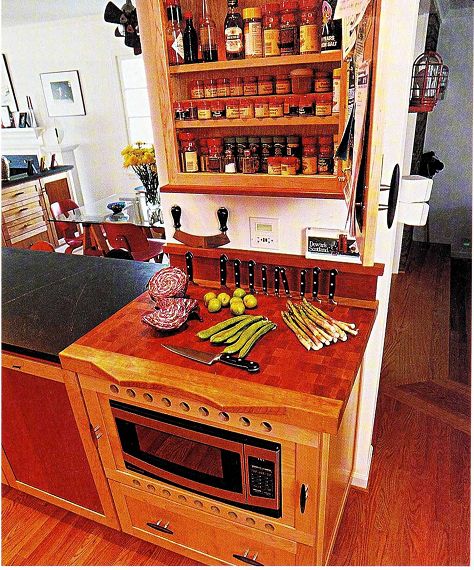
------- Spices stored over the oven? Fine, as long as it's a microwave.
With spices and knives within reach, this end-grain, butcher block workstation
makes food preparation a smooth and easy going affair.
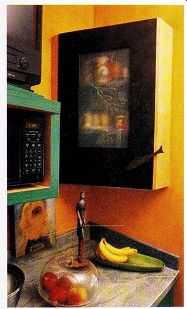
-------- This cabinet spice rack is a work of art. The Finland birch frame
is finished with pre-rusted steel and etched glass. The handle is--what else--a
fish.
It's not uncommon to see a spice rack hanging next to the stove, but that's not an ideal setup. Heat and light quickly degrade herbs and spices, so it's best to store them in a cool , dark place if possible. Many cooks keep favorite spices next to the cooktop and store backup spices in cooler spots, sometimes in the refrigerator. Spice storage depends on your sense of style, the way you cook, and your spice-buying habits. You may prefer identical spice jars that fi t into a drawer insert or on a rack attached to the inside of a cabinet door (make sure it clears the shelves) , or conversely, decanted into opaque containers and stored in the open. If a spice collection includes various-sized jars, boxes, and bags, it will be neater to store them in a drawer (label the lids for easier identification) or on a pantry shelf. And if you have a large spice collection, you will not regret keeping containers in rough alphabetical order. Slender pullout shelves in a base cabinet-remember, within reach of the work space but not near a source of heat-are tailor-made for spices.
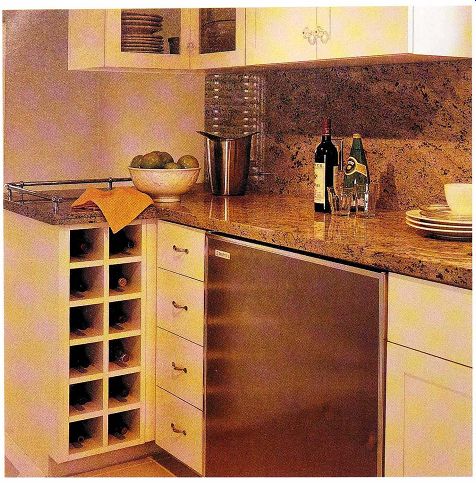
---------- It's fine to store everyday wine in the kitchen as long as it
doesn't sit for too long.
In this kitchen, a wine rack was built into a base cabinet.
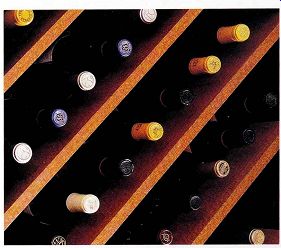
-------- A simple-but-elegant wine rack like this one can be placed in
the kitchen, dining room, or butler's pantry.
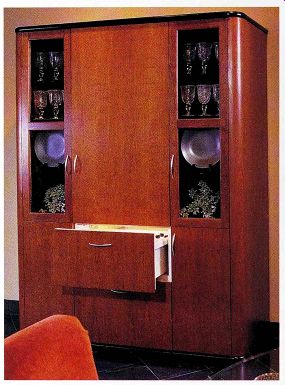
------------- A refrigerator drawer that's specifically ca librated for
wine can provide short-term storage for a dinner party, or it can be used as
a miniature wine cellar.
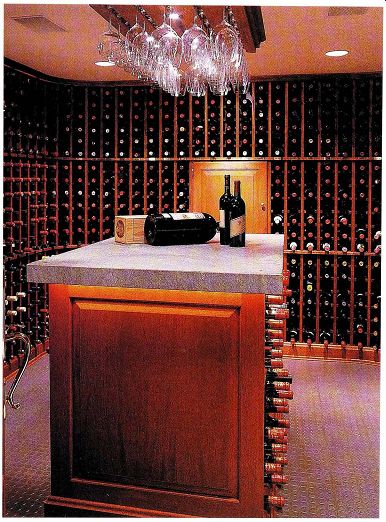
------------- A mahogany wine cellar provides chilled storage for a thousand
bottles of wine, plus a few wine tasters . A rack overhead keeps glasses dust-free
and with in reach. The door in the center background is a built-in humidor
for cigar storage.
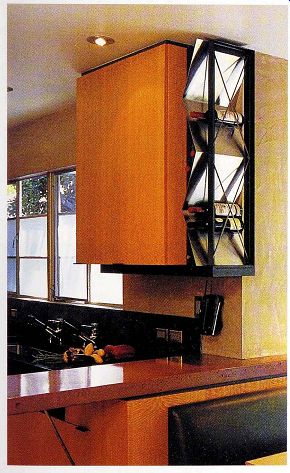
---------- A steel frame with folded metal plates and steel cables creates
a sculptural, short-term storage space for a few wine bottles in this Oakland,
California, kitchen.
Storing Wire
The way most of us store wine would curl the lip of any oenophile. The kitchen is no place for long-term wine storage, unless you've invested in a wine cooler. These miniature wine cellars, which fi t under the standard, 3-ft. -high countertop, chill wine to temperatures between 48°F and 60°F Much larger wine credenzas with 200-bottle capacities can be fitted up like fancy cabinetry, making them an elegant addition to a bar area or large dining room.
A pantry may not be as glamorous as a wine cellar, but if it's well ventilated, dark, and reasonably cool, it beats storing wine in the kitchen proper. A cool, dry basement is perfect for wine storage , whether it's in inexpensive wine racks or cardboard boxes turned on their sides. If you like to collect good wine, investing in a wine cooler or setting up a small basement room with an air conditioner can be money well spent. Researching and collecting young wines and saving them until their prime brings joy to many people, especially if they can relish the fact that they paid half or even a tenth of a mature-or suddenly trendy-wine's shelf price. But hardly anyone will object to storing non-pedigreed wine in slots in kitchen cabinets, as long as such units aren't near any obvious hot spots and the wine is consumed fairly soon.
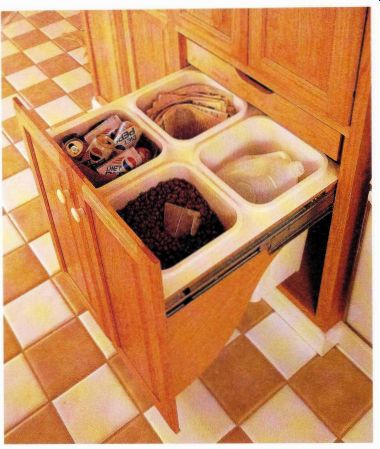
------------- Pullout trash drawers come in several configurations, colors,
and sizes. Multiple compartments allow for quick sorting.
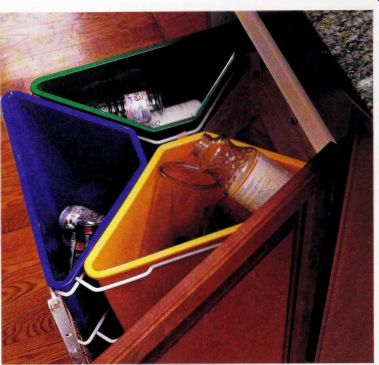
-------------- This work surface has an under-counter container to hold
vegetable trimmings, which are dumped on the compost heap daily.
Trash and Recyclables
These days, there are a multitude of cabinet accessories for holding trash and recyclables of all sorts. The easiest type to use are pullout receptacles, which--thankfully--don't often fit under the sink, making cleanup a much more harmonious experience for two or more people. Pullout receptacles bring the trash out at the level of the countertop, so it's easy to dump in scraps without bending over. Some pullout accessories include a shelf below the trash container; this is a great spot for storing trash bags . Your community's requirements for sorting recyclables will determine what kind of containers you need. A really thirsty family may require a bin solely for recyclable containers, plus one for returns, but it's hard to justify space for these big containers in the kitchen. A mudroom or outdoor closet (one that nocturnal critters can't access) is a suitable home for large bins.
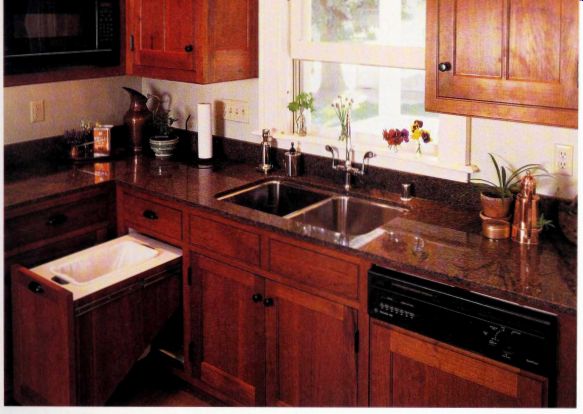
----------- Make every effort to store trash somewhere other than
under the sink; in this kitchen, it's stored in a pullout base cabinet compartment
for easy access.
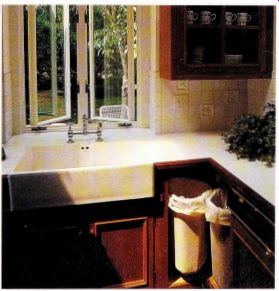
------ The corner doesn't have to be a tricky design problem.
In this kitchen it's fitted with a divided, rotating trash container.
============
Don't Forget a Fire Extinguisher
Afire extinguisher is a small item to store, but it can have a huge impact in a kitchen fire. It should be stored in an accessible location away from the stove, so it's easy (and safe) to grab during a fire. Ideally, an extinguisher should be mounted near an exit where it can be seen but is out of reach of children. A UL-listed, ABC, or all-purpose, extinguisher is a good choice for a kitchen. Do not depend on a fire extinguisher for anything but a small, contained fire, as it doesn't have the capacity for more than a few seconds of spray. The extinguisher should be charged after each use.
============
Cleaning Supplies
The unfortunate by-product or food is grease, grime, and trash. The kitchen is a major mess factory, so cleaning supplies should be kept in or very near the kitchen. You're much more likely to keep things clean if supplies are at hand. Under-the-sink storage is a common option, but powdered cleansers and dish washing detergent won't fare well in dampness. Broom closets are available as accessories for stock and custom cabinetry, but you can also build your own by designating space in the pantry for a broom, mop, vacuum, and bucket, with shelves (separate from food storage) for cleaning supplies. Wherever cleaning supplies are stored, make sure they're locked away from small children.
If a central vacuum is on your wish list, remember to include the kitchen; a vacuum port can be mounted on a wall or cabinet end.
Beyond Basic Kitchen Gear
The kitchen is frequently described as the heart of a home. And so it is, with many activities taking place besides food preparation Today's kitchens often incorporate places to sit, talk, work, play, and even to sleep (a built-in bench can make a great spot for a nap). Our new kitchen habits require another layer of storage that goes beyond kitchen gear and makes space for books, stationery, art supplies, even toddler toys. While it can be tricky to find this much space, doing so boosts the kitchen's usefulness and makes it an even happier place to be. Part of the secret to making room for everything is finding storage space for kitchen gear in other rooms as well. For those who still have a separate dining room, this is the first place to look; think of it as an extension of the kitchen. And because no kitchen or dining space is whole without a bit of embellishment, there should be space dedicated to art and your favorite collections.
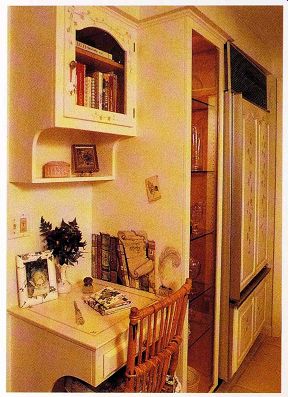
----------- Despite its diminutive size, this cook's desk still has room
for a number of cookbooks . A thin glass cabinet squeezes in between desk and
refrigerator.
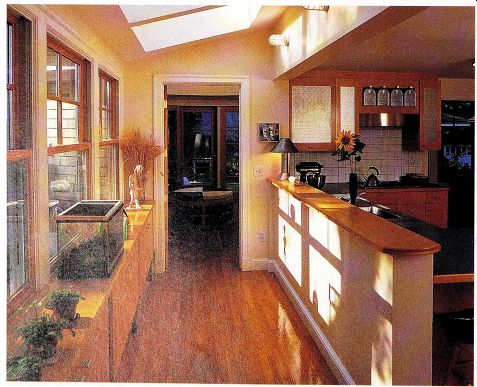
------- This hallway, a new addition to a dark, colonial-style house,
was a good investment, adding much needed light as well as additional storage
for kitchen gear, linens, and kids' toys.
It also reroutes traffic, keeping the kitchen clear of extraneous bodies. Yes, those are mailboxes over the cooktop.
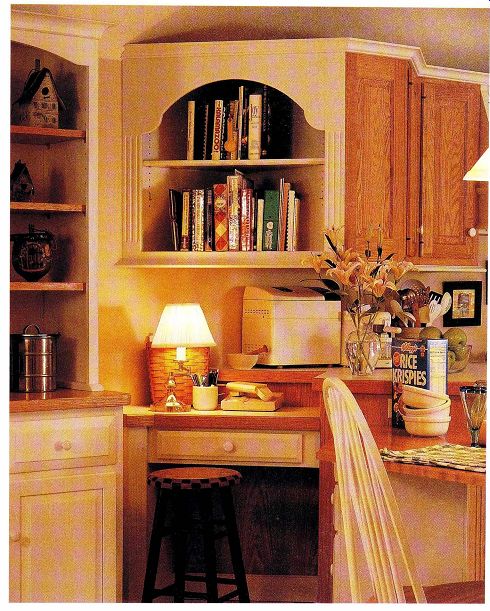
-------- This tiny desk is an extension of the breakfast nook, but it offers
enough room for a phone and a few cookbooks--all that's really needed from
a kitchen desk.
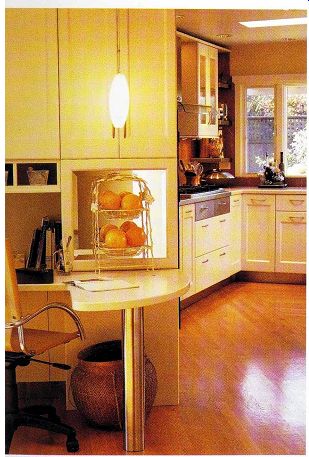
------- This desk pays homage to its surroundings by incorporating kitchen
gear into its setup, with bread pans used for storing mail.
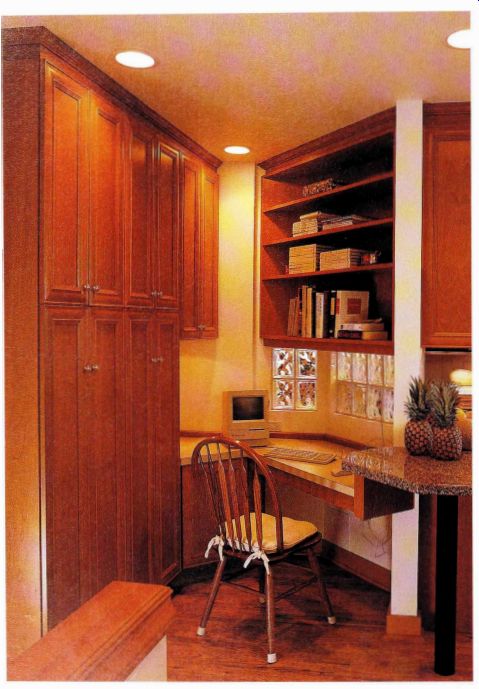
--------- Kitchen cabinets are angled to separate the work area from
the cook's desk, creating a cozy kitchen and a cozier place to read, write,
or ponder life's mysteries.
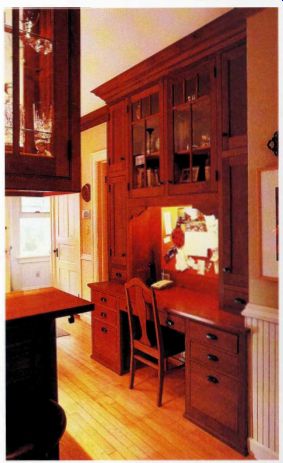
------- In this kitchen, the desk is part of a built-in cabinetry unit,
which makes it flow with the rest of the kitchen. The drawers are fitted for
hanging files, and a corkboard helps keep track of important papers.
Room for a Desk
Even though it eats up a lot of space, a desk in a kitchen is easy to justify when you really think about it. A desk allows you to multitask, keeping an eye on dinner while paying bills or finishing up business. School-age kids can use the space for homework under a watchful eye, and smaller children can hunker down over an art project. If you like to cook, chances are you collect cookbooks, which can be stored near the desk for reading and comparing recipes.
The desk should include all the usual nooks, like drawers for hanging fi les, a big drawer for phone books, and shallow drawers for pencils. A desk is an obvious place for the kitchen message center, so space for a phone and messages, whether on a tack-board, chalkboard, or both, should be included. If the kitchen desk includes a computer, leave part of the desk clean for other projects. Tuck computer accessories, such as a printer, on a shelf below the desk. A roll-down or tilt-in door can cover the desk work space during heavy-duty cooking sprees, or when company's coming.
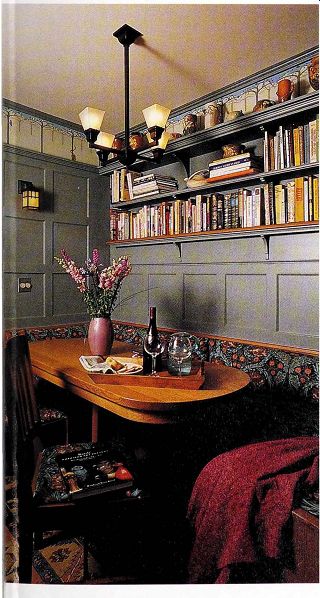
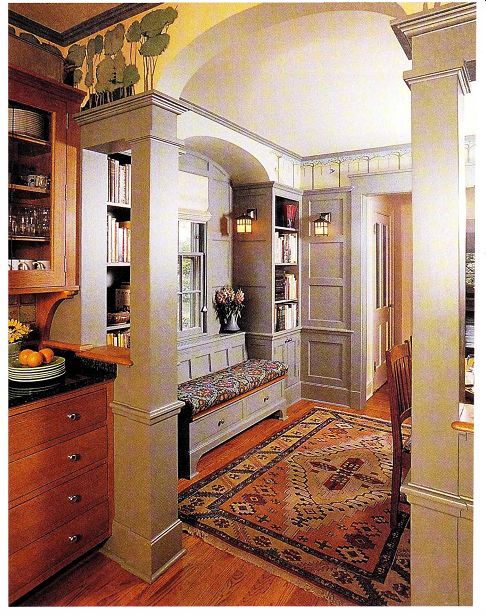
-------------- Books and pottery are displayed on shelves that blend in
with the wood paneling and look down on a breakfast banquette in this Arts
and Crafts house. Across from the banquette is a window seat and a short wall
of cabinetry that includes closed cabinets and open shelves.
Dining Spaces
Dining spaces can range dramatically in their character and use, but all dining spaces benefit from some storage capability. A breakfast nook or dining room with nothing but a table will suffer from disuse or disarray. Provide a built-in or freestanding sideboard for serving food, displaying large serving pieces, and storing table linens. Additional cabinets and hutches can accommodate runoff from the kitchen and will provide a secure location for china. If you don't need the extra storage , a dining-room cabinet may be the perfect spot for a sound system or to display art. And if you've been searching in vain for a place to put the bookshelf, the dining room may be just the place. A breakfast nook will benefit from a small bookshelf, too, and space to slack a few newspapers for peaceful, Sunday reading.
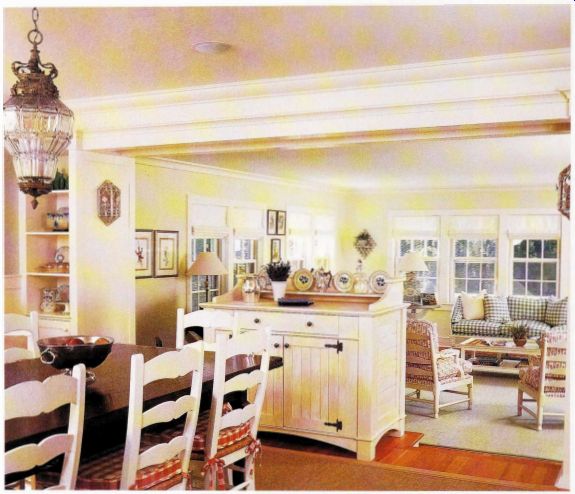
-------------- In this home, a family room and dining area share space,
but each is defined by a different floor level and set off by a hutch, which
functions as both screen and storage area.
Serving pieces, linens, and candles are stored in the hutch, and its top surface serves as a sideboard.
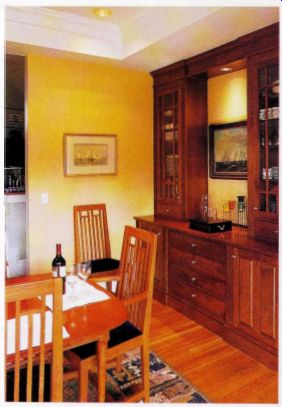
------- Rather than take up room in the kitchen, finer china and glassware
are stored in built- in cabinetry in the dining room, along with linens (in
the wide, shallow drawers) and serving pieces. Recessing the cabinet makes
it less obtrusive.
-------------

Plate Rails
Plate rails are built up of stock molding parts; many configurations and styles are possible.
Add brackets or dentils for more detail. Provide grooves or continuous beads on top of the rail to hold various-sized plates.
--------------

------------ Dining-room shelves are plastered seamlessly into the wall,
high lighting a collection of plates rather than the shelving itself.
Storing Art Collections
Kitchens and dining spaces frequently display collections of food-related objects that have a practical purpose, but there's nothing wrong with displaying art for art's sake , as well.
Consider the relatively greasy and dusty atmosphere, however, and choose items wisely.
Collections will be shown to their best advantage if you create a purposeful space specifically for them, rather than just plunking them down on the windowsill. Plates and similarly shaped objects can be displayed on a high plate rail, a narrow shelf set on crown or bed molding; a groove or stop on the rail al lows plates to lean against the wall without sliding off. Door frames can be given a flat top that extends the door profile and makes space for small collect ions, but be aware that closing doors can jar objects loose from their perch. Regardless of what you choose to display or how you display it, including art in your kitchen design will help it live up to its potential of being the heart of your home.